#ea lifecycle support services
Explore tagged Tumblr posts
Text
Unlocking Business Potential with Asset Tracking Systems: A Comprehensive Guide
In today’s business landscape, where maximizing efficiency and minimizing waste are top priorities, asset tracking systems have become indispensable. These systems provide companies with the tools to manage and monitor their assets in real-time, driving cost savings, reducing losses, and improving productivity. But what exactly are asset tracking systems, and how do they transform operations across industries? This guide explores how asset tracking systems work, the technologies behind them, and the unique benefits they offer businesses.
What is an Asset Tracking System?
An asset tracking system is a solution that enables organizations to monitor their physical assets, such as equipment, inventory, and vehicles, from a central platform. By tagging assets with unique identifiers and tracking them through various technologies, companies can instantly view an asset’s location, usage, and status. This visibility allows for greater control over assets, streamlined operations, and improved decision-making.
Core Technologies Behind Asset Tracking
Different asset types and business needs require various tracking technologies. Let’s look at the most common ones:
RFID (Radio Frequency Identification) RFID tags are small, wireless devices attached to assets, ideal for short-range tracking. RFID is especially effective for inventory management and is widely used in retail and warehousing.
GPS (Global Positioning System) GPS trackers offer precise, real-time location tracking, making them indispensable for fleets and other mobile assets. Logistics and transportation companies often use GPS to manage and monitor vehicle locations and routes.
Bluetooth Low Energy (BLE) BLE is cost-effective and suitable for indoor asset tracking over shorter distances. Hospitals and office buildings commonly use BLE to locate equipment or monitor assets within their facilities.
Barcode and QR Codes For simpler tracking needs, barcode and QR code scanning provide a low-cost, manual tracking solution. Though it requires scanning, it’s effective for inventory in retail or warehouses with limited budgets.
IoT Sensors IoT sensors enable real-time tracking of asset location, environmental conditions, and even usage data. Ideal for industries with strict environmental control needs, such as pharmaceuticals and food storage, these sensors provide comprehensive data to ensure product quality and safety.
Key Benefits of Asset Tracking Systems
Asset tracking systems bring a host of advantages to businesses, from cost savings to improved efficiency. Here are some of the key benefits:
1. Real-Time Visibility and Control
Asset tracking provides a bird’s-eye view of asset locations and conditions, allowing businesses to make timely, data-driven decisions. Real-time visibility helps reduce asset misplacement, loss, and downtime.
2. Improved Asset Utilization
By understanding how assets are being used, companies can optimize their allocation. Underutilized assets can be reassigned, while frequently used assets can be prioritized for upgrades or maintenance. This leads to more efficient resource management and lower operational costs.
3. Enhanced Security and Loss Prevention
For companies with high-value assets, security is paramount. Asset tracking systems offer location alerts and geofencing features that notify managers if an asset moves outside a designated area, significantly reducing the risk of theft or unauthorized use.
4. Maintenance and Lifecycle Management
Many asset tracking systems support preventive maintenance by automatically sending alerts when equipment requires servicing. This proactive approach extends the lifespan of assets and avoids costly repairs due to breakdowns.
5. Streamlined Auditing and Compliance
For regulated industries, tracking systems simplify compliance and auditing. By automatically logging asset histories and usage, they create a digital paper trail that is easy to access and verify, reducing the administrative burden during audits.
Industries Benefiting from Asset Tracking Systems
Asset tracking systems are transforming the way different sectors operate. Here are some examples of industries where asset tracking has a significant impact:
Healthcare
In healthcare, timely access to medical equipment can be critical. Hospitals use asset tracking to ensure that life-saving devices, such as defibrillators and ventilators, are always accessible. Additionally, tracking systems support strict sanitation and maintenance schedules, reducing risks for patients and staff.
Logistics and Transportation
For logistics companies, efficiency and speed are crucial. Asset tracking systems allow them to monitor vehicle locations in real-time, optimize delivery routes, and provide accurate ETAs to customers. This visibility minimizes delays and improves customer satisfaction.
Construction
Construction sites involve a wide range of equipment and tools spread across multiple locations. Asset tracking ensures that necessary tools are always available, reducing downtime and boosting productivity. It also enhances security by monitoring high-value assets that might otherwise be prone to theft.
Manufacturing
In manufacturing, tracking systems help monitor equipment usage and maintenance. This reduces the risk of unexpected downtime, allowing production lines to run smoothly. Tracking raw materials and finished products also ensures that inventory levels are sufficient to meet production demands.
Retail and Warehousing
Retailers use asset tracking to monitor inventory across multiple locations. Real-time visibility into stock levels helps prevent stockouts and ensures that items are available when needed, enhancing the customer experience.
Implementation Tips: How to Get Started with Asset Tracking
Define Your Tracking Goals Start by identifying your key objectives. Do you need to prevent asset loss, improve maintenance, or reduce operational costs? Clear goals will guide the selection of the right system features and technologies.
Choose the Right Tracking Technology Match the technology to your asset type and goals. For instance, RFID might work best in a retail setting, while GPS is ideal for mobile assets like trucks. Consider your environment, budget, and tracking range when making this choice.
Integrate with Existing Systems An asset tracking system works best when integrated with other business software, such as ERP or inventory management systems. This integration streamlines data flow and allows for a more holistic approach to asset management.
Ensure Employee Training Your employees are key to successful implementation. Provide training on how to use the tracking system and ensure they understand its benefits. Proper training improves adoption rates and maximizes the value of the system.
Monitor and Optimize Regularly analyze tracking data to find improvement opportunities. Many tracking systems offer analytics features to help you understand asset utilization patterns, which can guide decisions on redeployment, maintenance, or disposal.
Emerging Trends in Asset Tracking Systems
As technology evolves, asset tracking systems are integrating more advanced features that further enhance functionality. Here are some trends to watch:
Artificial Intelligence (AI) and Predictive Analytics
AI-driven analytics are increasingly used to forecast maintenance needs, predict asset wear, and identify utilization patterns. Predictive analytics enable businesses to preemptively address issues, reducing downtime and extending asset life.
Blockchain for Secure Asset Management
Blockchain technology provides a secure, decentralized record of asset transactions and histories. It’s particularly beneficial for high-value assets or sensitive data, offering an additional layer of security and transparency.
5G Connectivity for Real-Time Data
With 5G networks, data transmission becomes faster and more reliable, enabling real-time tracking of assets even in remote or high-density environments. This advancement enhances the capabilities of IoT-based asset tracking and improves overall system performance.
Augmented Reality (AR) for Visual Asset Location
AR is transforming how employees interact with assets. Through AR-enabled devices, workers can visually locate assets in warehouses or large facilities, reducing search time and improving productivity.
Conclusion: Why Asset Tracking is Essential in Modern Business
Asset tracking systems are reshaping asset management across industries. By providing real-time insights into asset location, usage, and condition, these systems empower companies to boost operational efficiency, enhance security, and make data-driven decisions. In sectors from healthcare to manufacturing, asset tracking has proven its value as a cost-saving, productivity-boosting solution.
For companies looking to stay competitive and agile, investing in an asset tracking system is a strategic move. With advancements in IoT, AI, and 5G, these systems will continue to evolve, offering even greater precision and control. Asset tracking is no longer just an operational tool — it’s a critical part of a modern, streamlined business strategy that optimizes resources, improves service quality, and drives growth.
0 notes
Text
Transform Your Business with SEAL Infotech: Leading Enterprise Application Services and IT Outsourcing in Dubai

The Importance of Enterprise Application Services
Enterprise Application Services in Duba (EAS) are crucial for businesses aiming to streamline their operations and improve efficiency. These services involve the implementation and management of software applications that support business processes across various functions such as finance, human resources, supply chain management, and customer relationship management.
Key Benefits of Enterprise Application Services:
Operational Efficiency: EAS streamline and automate business processes, reducing manual efforts and minimizing errors.
Data Integration: These services ensure seamless integration of data across different departments, providing a single source of truth for decision-making.
Scalability: Enterprise applications can be scaled according to business growth, ensuring that your technology infrastructure keeps pace with your expanding needs.
Enhanced Collaboration: EAS facilitate better communication and collaboration among employees, leading to improved productivity and innovation.
SEAL Infotech: Your Partner for Enterprise Application Services in Dubai
At SEAL Infotech, we offer comprehensive Enterprise Application Services tailored to meet the unique needs of businesses in Dubai. Our services encompass the entire lifecycle of enterprise applications, from planning and implementation to maintenance and support.
Our Enterprise Application Services Include:
ERP Solutions: We provide robust ERP solutions that integrate all facets of your business operations, including finance, HR, supply chain, and more.
CRM Systems: Our CRM systems help you manage customer relationships more effectively, improving customer satisfaction and loyalty.
Supply Chain Management: We offer solutions that optimize your supply chain operations, ensuring timely delivery and reducing costs.
HR Management Systems: Our HR solutions streamline HR processes, from recruitment and onboarding to payroll and performance management.
Business Intelligence: We provide business intelligence tools that offer valuable insights into your operations, helping you make data-driven decisions.
The Role of IT Outsourcing in Business Success
In today’s digital age, IT plays a pivotal role in the success of any business. However, managing IT functions in-house can be resource-intensive and distract from core business activities. This is where IT outsourcing comes into play. By partnering with an IT outsourcing company, businesses can access specialized skills, reduce costs, and focus on their strategic objectives.
Advantages of IT Outsourcing:
Cost Efficiency: Outsourcing IT functions can significantly reduce operational costs by eliminating the need for in-house IT infrastructure and personnel.
Access to Expertise: IT outsourcing companies bring specialized knowledge and skills, ensuring high-quality service and support.
Scalability: Outsourcing allows businesses to scale their IT services according to their needs, providing flexibility and agility.
Focus on Core Business: By outsourcing IT functions, businesses can focus on their core activities, driving growth and innovation.
SEAL Infotech: Leading IT Outsourcing Company in Dubai

SEAL Infotech stands out as one of the leading IT outsourcing companies in Dubai, offering a wide range of services designed to meet the diverse needs of businesses. Our team of experienced professionals is dedicated to delivering high-quality IT solutions that enhance your business performance.
Our IT Outsourcing Services Include:
IT Support and Maintenance: We provide round-the-clock support and maintenance services to ensure your IT infrastructure runs smoothly.
Cloud Services: Our cloud solutions offer secure, scalable, and cost-effective options for data storage, applications, and computing power.
Network Management: We manage your network infrastructure, ensuring reliable connectivity and optimal performance.
Cybersecurity: Our cybersecurity services protect your business from cyber threats, ensuring the safety of your data and systems.
Software Development: We offer custom software development services tailored to meet your specific business needs.
Why Choose SEAL Infotech?
SEAL Infotech is committed to delivering excellence in every project we undertake. Here’s why you should partner with us:
Experience and Expertise: With years of experience and a team of skilled professionals, we have the expertise to deliver high-quality IT and enterprise application services.
Customer-Centric Approach: We prioritize our clients’ needs, ensuring that our solutions are tailored to meet their specific requirements.
Innovation: We leverage the latest technologies and innovative approaches to provide cutting-edge solutions that drive business success.
Reliability: Our commitment to reliability and excellence ensures that we deliver on our promises, providing peace of mind for our clients.
Conclusion
In the dynamic business landscape of Dubai, staying competitive requires leveraging the best in enterprise application services and IT outsourcing. SEAL Infotech is your trusted partner in this journey, offering comprehensive solutions that enhance efficiency, reduce costs, and drive business growth. Whether you need robust ERP systems, efficient CRM solutions, or reliable IT support, SEAL Infotech has the expertise and experience to meet your needs.
Transform your business with SEAL Infotech’s enterprise application services and IT outsourcing solutions. Contact us today to learn more about how we can help you achieve your business objectives and stay ahead in the competitive market.
0 notes
Link
#healthcare information technology#emerging technology solutions in healthcare#rpa emerging technology services in healthcare#robotic process automation service providers#healthcare services consulting firm usa#software test management tools#agile testing methodology#defense architecture framework dodaf alignments#DoD Business Enterprise Architecture#infrastructure operations and maintenance services#enterprise agile transformation services#DoD Test and Evaluation Management#ea lifecycle support services#dod ehr modernization project services#mhs genesis training support services#data center infrastructure management operations#data visualization consulting services in usa#use of ai and robotics in healthcare industry#computer vision and image processing consulting#develop predictive model using nlp#human centered design process services#automation testing tools in software testing#software test automation solutions in usa
2 notes
·
View notes
Text

USAF starts new 'family' program of state-of-the-art refuelers with request for information
Fernando Valduga By Fernando Valduga 06/30/2022 - 12:00 PM in Military
The U.S. Air Force (USAF) placed another "nake in the coffin" of a potential tanker aircraft competition with the launch of the Advanced Aerial Refueling Family of Systems (AAR FoS) program.
In a request for information from the U.S. Air Force Lifecycle Management Center (AFLCMC), the service informed the aviation industry that it is seeking significant improvements in existing tankers, while seeking to define a much more capable future system. Among the new missions of tankers will be electronic warfare and the refueling of unmanned aircraft.
In a June 22 announcement, the AFLCMC called the AAR FoS “an evolutionary approach to adding new capacity to the current fleet of tanker aircraft (KC46A/KC-135R/T), while developing the general requirements for a new refueling aircraft”. This two-way approach "will more effectively implement solutions that improve the operations of the tanker fleet".

New refueling aircraft family is expected to replace all current aircraft of this function in the USAF: KC-135, KC-10 and KC-46.
While some of the "new and mature technologies" sought after by the industry will be used to upgrade the KC-46 and KCX-135, others "in the early stages of development and maturation" will continue to be developed for the still indefinite KC-Z effort, which has been described by transport leaders as a potentially smaller and stealthy aircraft that can escort fighters
"Current and future tankers will be required to command, control and communicate globally efficiently, navigate accurately in degraded environments and carry out high-paced operations in contested environments," the U.S. Air Force said.
Among the capabilities that tankers will need are:
Connectivity: "resilient line of sight (LOS) and beyond line of sight (BLOS) with aerial connectivity with the future Joint Command and Control of All Domains environment (JADC2)"
Open architecture design, federated systems and data streams;
Alternative forms of positioning, navigation and time (PNT)
Tanker planes will also have to have “greater survivability and mission effectiveness, greater situational awareness that enhances situational understanding, electronic warfare (EW)/electronic attack (EA) on board and ... interoperability with external autonomous collaborative platforms”.
The latter, known as ACPs, are unmanned aircraft that will escort future manned combat aircraft, performing missions such as electronic attack and suppression of enemy air defenses, as well as intelligence, surveillance and reconnaissance, and as flight teams with extra weapons. The manned aircraft designates the target for the unmanned aircraft missile to be fired.

The U.S. Air Force has several times started a program to equip the B-52 with an electronic warfare capability throughout the theater called the B-52 Stand Off Jammer, but the program was canceled every time due to budget considerations. Service officials have long said that tankers would be suitable for this role due to their proximity to the action.
The capabilities of the System Family need to inject agility into the mission, facilitating "fast operations, improved fuel efficiency, improved maintenance procedures, improved access to the aerodrome and reduced maintenance requirements and logistical support," said the U.S. Air Force.
As these new features are inserted into existing tankers and as new technologies are developed, the combination “will shape the requirements for future refueling aircraft,” the service said.
The minimum requirements for improved tanker capacity may involve, but are not limited to, "survival (kinetic and non-kinetic defensive systems); Real-Time Situational Awareness; Connectivity/Data; Interoperability" and "autonomous refueling operations as a refueler or receiver for manned and unmanned platforms, in boom and hose configurations".

By launching new technologies, the U.S. Air Force wants respondents to declare the level of technological readiness (TRL) of the capabilities being proposed. A TRL indicates whether a new technology is still in the concept/experimental stage (TRLs 1-2) or practically ready for production (TRL 6-7), or already operationally proven (TRL 10). The service also wants cost estimates and proposed schedules for the insertion of these technologies, if they have been applied in other programs, and any form/adjustment/function problems that may arise.
The U.S. Air Force wants to hear from companies interested in offering new features by July 8.
Since the 2023 fiscal budget request was submitted to Congress, Air Force Secretary Frank Kendall has minimized the possibility of a "bridge replenisher" competition for the so-called KC-Y, saying that the requirements developed so far would probably be more economical achieved by an updated version of the KC-46A, built by Boeing.

Lockheed is still waiting for a "bridge aircraft" competition where it can offer Airbus' A330 MRTT.
Air Force officials also said in particular that, if it can avoid it, the service would like to avoid adding a new platform, which would require the logistical support of a warehouse, a spare parts pipeline and military construction to accommodate a different plane.
Source: Air Force Magazine
Tags: Military AviationKC-ZREVO - Air RefuelingUSAF - United States Air Force / U.S. Air Force
Previous news
Sweden places an order for two Saab GlobalEye aircraft
Fernando Valduga
Fernando Valduga
Aviation photographer and pilot since 1992, he has participated in several events and air operations, such as Cruzex, AirVenture, Dayton Airshow and FIDAE. He has works published in a specialized aviation magazine in Brazil and abroad. He uses Canon equipment during his photographic work in the world of aviation.
Related news
MILITARY
Sweden places an order for two Saab GlobalEye aircraft
06/30/2022 - 11:00 AM
F-16 fighters of the Turkish Air Force. (Photo: Arnaud Chamberlin)
MILITARY
Pentagon said it fully supports Turkey's acquisition of F-16 fighters
06/30/2022 - 08:49 AM
Sikorsky's entry into the Army's Future Attack Reconnaissance Aircraft (FARA) program is now 90% complete and approaches the first flight. (Photo: Sikorsky)
HELICOPTERS
Sikorsky Raider X is 90% complete
06/30/2022 - 06:00 AM
CH-53K King Stallion.
HELICOPTERS
Belgium evaluates purchase of new heavy cargo helicopters
06/29/2022 - 6:00 PM
MILITARY
Ukraine orders dozens of Bayraktar TB2 drones made in Turkey with deliveries scheduled for July
06/29/2022 - 4:00 PM
Raytheon Multi-Program Testbed takes off from Andersen Air Base in Guam during Valiant Shield 2022. (Photo: US Army 55th Signal Company)
MILITARY
Raytheon demonstrates critical ability to Command and Control Joint All Domains for U.S. military personnel
06/29/2022 - 14:00
HOME Main Page Editorials Information Events Collaborate SPECIALS Advertise About
Cavok Brasil - Digital Tchê Web Creation
Commercial
Executive
Helicopters
History
Military
Brazilian Air Force
Space
SPECIALS
Cavok Brasil - Digital Tchê Web Creation
8 notes
·
View notes
Text
In this guide we will perform an installation of Red Hat OpenShift Container Platform 4.11 on KVM Virtual Machines. OpenShift is a powerful, platform agnostic, enterprise-grade Kubernetes distribution focused on developer experience and application security. The project is developed and owned by Red Hat Software company. OpenShift Container Platform is built around containers orchestrated and managed by Kubernetes on a foundation of Red Hat Enterprise Linux. The OpenShift platform offers automated installation, upgrades, and lifecycle management throughout the container stack – from the operating system, Kubernetes and cluster services, to deployed applications. Operating system that will be used on both the Control plan and Worker machines is Red Hat CoreOS (RHCOS). The RHCOS OS includes the kubelet, which is the Kubernetes node agent, and the CRI-O container runtime optimized for Kubernetes workloads. In my installation the deployment is performed on a single node KVM compute server. This is not a production setup with high availability and should only be used for proof-of-concept and demo related purposes. Red Hat’s recommendation on each cluster virtual machine minimum hardware requirements is as shown in the table below: Virtual Machine Operating System vCPU Virtual RAM Storage Bootstrap RHCOS 4 16 GB 120 GB Control plane RHCOS 4 16 GB 120 GB Compute RHCOS 2 8 GB 120 GB But the preferred requirements for each cluster virtual machine are: Virtual Machine Operating System vCPU Virtual RAM Storage Bootstrap RHCOS 4 16 GB 120 GB Control plane RHCOS 8 16 GB 120 GB Compute RHCOS 6 8 GB 120 GB The shared hardware requirements information for the virtual machines is not accurate since it depends on the workloads and desired cluster size when running in Production. Sizing can be done as deemed fit. My Lab environment variables OpenShift 4 Cluster base domain: example.com ( to be substituted accordingly) OpenShift 4 Cluster name: ocp4 ( to be substituted accordingly) OpenShift KVM network bridge: openshift4 OpenShift Network Block: 192.168.100.0/24 OpenShift Network gateway address: 192.168.100.1 Bastion / Helper node IP Address (Runs DHCP, Apache httpd, HAProxy, PXE, DNS) – 192.168.100.254 NTP server used: time.google.com Used Mac Addresses and IP Addresses: Machine Name Mac Address (Generate yours and use) DHCP Reserved IP Address bootstrap.ocp4.example.com 52:54:00:a4:db:5f 192.168.100.10 master01.ocp4.example.com 52:54:00:8b:a1:17 192.168.100.11 master02.ocp4.example.com 52:54:00:ea:8b:9d 192.168.100.12 master03.ocp4.example.com 52:54:00:f8:87:c7 192.168.100.13 worker01.ocp4.example.com 52:54:00:31:4a:39 192.168.100.21 worker02.ocp4.example.com 52:54:00:6a:37:32 192.168.100.22 worker03.ocp4.example.com 52:54:00:95:d4:ed 192.168.100.23 Step 1: Setup KVM Infrastructure (On Hypervisor Node) Install KVM in your hypervisor node using any of the guides in below links: Install KVM Hypervisor on Ubuntu How To Install KVM Hypervisor on Debian Install KVM on RHEL 8 / CentOS 8 / Rocky Linux After installation verify your server CPU has support for Intel VT or AMD-V Virtualization extensions: cat /proc/cpuinfo | egrep "vmx|svm" Creating Virtual Network (optional, you can use existing network) Create a new virtual network configuration file vim virt-net.xml File contents: openshift4 Create a virtual network using this file file created; modify if need be: $ sudo virsh net-define --file virt-net.xml Network openshift4 defined from virt-net.xml Set the network to autostart on boot $ sudo virsh net-autostart openshift4 Network openshift4 marked as autostarted $ sudo virsh net-start openshift4 Network openshift4 started Confirm that the bridge is available and active:
$ brctl show bridge name bridge id STP enabled interfaces openshift4 8000.5254002b479a yes virbr0 8000.525400ad641d yes Step 2: Create Bastion / Helper Virtual Machine Create a Virtual Machine that will host some key services from officially provided virt-builder images. The virtual machine will be used to run the following services: DNS Server (Bind) Apache httpd web server HAProxy Load balancer DHCP & PXE/TFTP services It will also be our bastion server for deploying and managing OpenShift platform (oc, openshift-install, kubectl, ansible) Let’s first display available OS templates with command below: $ virt-builder -l I’ll create a VM image from fedora-36 template; you can also choose a CentOS template(8 or 7): sudo virt-builder fedora-36 --format qcow2 \ --size 20G -o /var/lib/libvirt/images/ocp-bastion-server.qcow2 \ --root-password password:StrongRootPassw0rd Where: fedora-36 is the template used to create a new virtual machine /var/lib/libvirt/images/ocp-bastion-server.qcow2 is the path to VM qcow2 image StrongRootPassw0rd is the root user password VM image creation progress will be visible in your screen [ 1.0] Downloading: http://builder.libguestfs.org/fedora-36.xz ########################################################################################################################################################### 100.0% [ 15.3] Planning how to build this image [ 15.3] Uncompressing [ 18.2] Resizing (using virt-resize) to expand the disk to 20.0G [ 39.7] Opening the new disk [ 44.1] Setting a random seed [ 44.1] Setting passwords [ 45.1] Finishing off Output file: /var/lib/libvirt/images/ocp-bastion-server.qcow2 Output size: 20.0G Output format: qcow2 Total usable space: 20.0G Free space: 19.0G (94%) Now create a Virtual Machine to be used as DNS and DHCP server with virt-install Using Linux bridge: sudo virt-install \ --name ocp-bastion-server \ --ram 4096 \ --vcpus 2 \ --disk path=/var/lib/libvirt/images/ocp-bastion-server.qcow2 \ --os-type linux \ --os-variant rhel8.0 \ --network bridge=openshift4 \ --graphics none \ --serial pty \ --console pty \ --boot hd \ --import Using openVSwitch bridge: Ref How To Use Open vSwitch Bridge on KVM Virtual Machines sudo virt-install \ --name ocp-bastion-server \ --ram 4096 \ --disk path=/var/lib/libvirt/images/ocp-bastion-server.qcow2 \ --vcpus 2 \ --os-type linux \ --os-variant rhel8.0 \ --network=bridge:openshift4,model=virtio,virtualport_type=openvswitch \ --graphics none \ --serial pty \ --console pty \ --boot hd \ --import When your VM is created and running login as root user and password set initially: Fedora 36 (Thirty Six) Kernel 5.xx.fc36.x86_64 on an x86_64 (ttyS0) fedora login: root Password: StrongRootPassw0rd You can reset root password after installation if that’s your desired action: [root@fedora ~]# passwd Changing password for user root. New password: Retype new password: passwd: all authentication tokens updated successfully. If the server didn’t get IP address from DHCP server you can set static IP manually on the primary interface: # ip link show 1: lo: mtu 65536 qdisc noqueue state UNKNOWN mode DEFAULT group default qlen 1000 link/loopback 00:00:00:00:00:00 brd 00:00:00:00:00:00 2: enp1s0: mtu 1500 qdisc fq_codel state UP mode DEFAULT group default qlen 1000 link/ether 52:54:00:21:fb:33 brd ff:ff:ff:ff:ff:ff # vi /etc/sysconfig/network-scripts/ifcfg-enp1s0 NAME="enp1s0" # Set network name, usually same as device name DEVICE="enp1s0" # Set your interface name as shown while running ip link show command ONBOOT="yes" NETBOOT="yes" BOOTPROTO="none" TYPE="Ethernet" PROXY_METHOD="none" BROWSER_ONLY="no" DEFROUTE="yes" IPADDR=192.168.100.254 # Set your VM IP address
PREFIX=27 # Set Netmask Prefix GATEWAY=192.168.100.1 # Set network gateway IP address DNS1=8.8.8.8 # Set first DNS server to be used DNS2=8.8.4.4 # Set secondary DNS server to be used # Once configured bring up the interface using ifup command # ifup enp1s0 Connection successfully activated (D-Bus active path: /org/freedesktop/NetworkManager/ActiveConnection/7) Test external connectivity from the VM: # ping -c 2 8.8.8.8 PING 8.8.8.8 (8.8.8.8) 56(84) bytes of data. 64 bytes from 8.8.8.8: icmp_seq=1 ttl=117 time=4.98 ms 64 bytes from 8.8.8.8: icmp_seq=2 ttl=117 time=5.14 ms --- 8.8.8.8 ping statistics --- 2 packets transmitted, 2 received, 0% packet loss, time 1001ms rtt min/avg/max/mdev = 4.981/5.061/5.142/0.080 ms # ping -c 2 google.com PING google.com (172.217.18.110) 56(84) bytes of data. 64 bytes from zrh04s05-in-f110.1e100.net (172.217.18.110): icmp_seq=1 ttl=118 time=4.97 ms 64 bytes from fra16s42-in-f14.1e100.net (172.217.18.110): icmp_seq=2 ttl=118 time=5.05 ms --- google.com ping statistics --- 2 packets transmitted, 2 received, 0% packet loss, time 1002ms rtt min/avg/max/mdev = 4.971/5.008/5.045/0.037 ms Perform OS upgrade before deploying other services. sudo dnf -y upgrade sudo dnf -y install git vim wget curl bash-completion tree tar libselinux-python3 firewalld Reboot the server after the upgrade is done. sudo reboot Confirm you can access the VM through virsh console or ssh $ sudo virsh list Id Name State ------------------------------------- 1 ocp-bastion-server running $ sudo virsh console ocp-bastion-server Connected to domain 'ocp-bastion-server' Escape character is ^] (Ctrl + ]) fedora login: Enable domain autostart: sudo virsh autostart ocp-bastion-server Step 3: Install Ansible and Configure variables on Bastion / Helper node Install Ansible configuration management tool on the Bastion machine # Fedora sudo dnf -y install git ansible vim wget curl bash-completion tree tar libselinux-python3 # CentOS 8 / Rocky Linux 8 sudo yum -y install epel-release sudo yum -y install git ansible vim wget curl bash-completion tree tar libselinux-python3 # CentOS 7 sudo yum -y install epel-release sudo yum -y install git ansible vim wget curl bash-completion tree tar libselinux-python We have a Github repository with all the tasks and templates used in this guide. Clone the project to ~/ocp4_ansible directory. cd ~/ git clone https://github.com/jmutai/ocp4_ansible.git cd ~/ocp4_ansible You can view the directory structure using tree command: $ tree . ├── ansible.cfg ├── files │ └── set-dns-serial.sh ├── handlers │ └── main.yml ├── inventory ├── LICENSE ├── README.md ├── tasks │ ├── configure_bind_dns.yml │ ├── configure_dhcpd.yml │ ├── configure_haproxy_lb.yml │ └── configure_tftp_pxe.yml ├── templates │ ├── default.j2 │ ├── dhcpd.conf.j2 │ ├── dhcpd-uefi.conf.j2 │ ├── haproxy.cfg.j2 │ ├── named.conf.j2 │ ├── pxe-bootstrap.j2 │ ├── pxe-master.j2 │ ├── pxe-worker.j2 │ ├── reverse.j2 │ └── zonefile.j2 └── vars └── main.yml 5 directories, 21 files Edit ansible configuration file and modify to suit your use. $ vim ansible.cfg [defaults] inventory = inventory command_warnings = False filter_plugins = filter_plugins host_key_checking = False deprecation_warnings=False retry_files = false When not executing ansible as root user you can addprivilege_escalation section. [privilege_escalation] become = true become_method = sudo become_user = root become_ask_pass = false If running on the localhost the inventory can be set as below: $ vim inventory [vmhost] localhost ansible_connection=local These are service handlers created and will be referenced in bastion setup process tasks. $ vim handlers/main.yml --- - name: restart tftp service: name: tftp state: restarted - name: restart bind service:
name: named state: restarted - name: restart haproxy service: name: haproxy state: restarted - name: restart dhcpd service: name: dhcpd state: restarted - name: restart httpd service: name: httpd state: restarted Modify the default variables file inside vars folder: vim vars/main.yml Define all the variables required correctly. Be careful not to have wrong values which will cause issues at the time of OpenShift installation. --- ppc64le: false uefi: false disk: vda #disk where you are installing RHCOS on the masters/workers helper: name: "bastion" #hostname for your helper node ipaddr: "192.168.100.254" #current IP address of the helper networkifacename: "ens3" #interface of the helper node,ACTUAL name of the interface, NOT the NetworkManager name dns: domain: "example.com" #DNS server domain. Should match baseDomain inside the install-config.yaml file. clusterid: "ocp4" #needs to match what you will for metadata.name inside the install-config.yaml file forwarder1: "8.8.8.8" #DNS forwarder forwarder2: "1.1.1.1" #second DNS forwarder lb_ipaddr: " helper.ipaddr " #Load balancer IP, it is optional, the default value is helper.ipaddr dhcp: router: "192.168.100.1" #default gateway of the network assigned to the masters/workers bcast: "192.168.100.255" #broadcast address for your network netmask: "255.255.255.0" #netmask that gets assigned to your masters/workers poolstart: "192.168.100.10" #First address in your dhcp address pool poolend: "192.168.100.50" #Last address in your dhcp address pool ipid: "192.168.100.0" #ip network id for the range netmaskid: "255.255.255.0" #networkmask id for the range. ntp: "time.google.com" #ntp server address dns: "" #domain name server, it is optional, the default value is set to helper.ipaddr bootstrap: name: "bootstrap" #hostname (WITHOUT the fqdn) of the bootstrap node ipaddr: "192.168.100.10" #IP address that you want set for bootstrap node macaddr: "52:54:00:a4:db:5f" #The mac address for dhcp reservation masters: - name: "master01" #hostname (WITHOUT the fqdn) of the master node (x of 3) ipaddr: "192.168.100.11" #The IP address (x of 3) that you want set macaddr: "52:54:00:8b:a1:17" #The mac address for dhcp reservation - name: "master02" ipaddr: "192.168.100.12" macaddr: "52:54:00:ea:8b:9d" - name: "master03" ipaddr: "192.168.100.13" macaddr: "52:54:00:f8:87:c7" workers: - name: "worker01" #hostname (WITHOUT the fqdn) of the worker node you want to set ipaddr: "192.168.100.21" #The IP address that you want set (1st node) macaddr: "52:54:00:31:4a:39" #The mac address for dhcp reservation (1st node) - name: "worker02" ipaddr: "192.168.100.22" macaddr: "52:54:00:6a:37:32" - name: "worker03" ipaddr: "192.168.100.23" macaddr: "52:54:00:95:d4:ed" Generating unique mac addresses for bootstrap, worker and master nodes You can generate all required mac addresses using the command below: date +%s | md5sum | head -c 6 | sed -e 's/\([0-9A-Fa-f]\2\\)/\1:/g' -e 's/\(.*\):$/\1/' | sed -e 's/^/52:54:00:/' Step 4: Install and Configure DHCP serveron Bastion / Helper node Install dhcp-server rpm package using dnf or yum package manager. sudo yum -y install dhcp-server Enable dhcpd service to start on system boot $ sudo systemctl enable dhcpd Created symlink /etc/systemd/system/multi-user.target.wants/dhcpd.service → /usr/lib/systemd/system/dhcpd.service.
Backup current dhcpd configuration file. If the server is not new you can modify existing configuration sudo mv /etc/dhcp/dhcpd.conf /etc/dhcp/dhcpd.conf.bak Task to configure dhcp server on the bastion server: $ vim tasks/configure_dhcpd.yml --- # Setup OCP4 DHCP Server on Helper Node - hosts: all vars_files: - ../vars/main.yml handlers: - import_tasks: ../handlers/main.yml tasks: - name: Write out dhcp file template: src: ../templates/dhcpd.conf.j2 dest: /etc/dhcp/dhcpd.conf notify: - restart dhcpd when: not uefi - name: Write out dhcp file (UEFI) template: src: ../templates/dhcpd-uefi.conf.j2 dest: /etc/dhcp/dhcpd.conf notify: - restart dhcpd when: uefi Configure DHCP server using ansible, defined variables and templates shared. $ ansible-playbook tasks/configure_dhcpd.yml PLAY [all] ******************************************************************************************************************************************************* TASK [Gathering Facts] ******************************************************************************************************************************************* ok: [localhost] TASK [Write out dhcp file] *************************************************************************************************************************************** changed: [localhost] TASK [Write out dhcp file (UEFI)] ******************************************************************************************************************************** skipping: [localhost] RUNNING HANDLER [restart dhcpd] ********************************************************************************************************************************** changed: [localhost] PLAY RECAP ******************************************************************************************************************************************************* localhost : ok=3 changed=2 unreachable=0 failed=0 skipped=1 rescued=0 ignored=0 Confirm that dhcpd service is in running state: $ systemctl status dhcpd ● dhcpd.service - DHCPv4 Server Daemon Loaded: loaded (/usr/lib/systemd/system/dhcpd.service; enabled; vendor preset: disabled) Active: active (running) since Tue 2021-08-17 19:35:06 EDT; 2min 42s ago Docs: man:dhcpd(8) man:dhcpd.conf(5) Main PID: 24958 (dhcpd) Status: "Dispatching packets..." Tasks: 1 (limit: 4668) Memory: 9.7M CPU: 17ms CGroup: /system.slice/dhcpd.service └─24958 /usr/sbin/dhcpd -f -cf /etc/dhcp/dhcpd.conf -user dhcpd -group dhcpd --no-pid ... You can as well check generated configuration file: $ cat /etc/dhcp/dhcpd.conf Step 4: Configure OCP Zone on Bind DNS Serveron Bastion / Helper node We can now begin the installation of DNS and DHCP server packages required to run OpenShift Container Platform on KVM. sudo yum -y install bind bind-utils Enable the service to start at system boot up sudo systemctl enable named Install DNS Serialnumber generator script: $ sudo vim /usr/local/bin/set-dns-serial.sh #!/bin/bash dnsserialfile=/usr/local/src/dnsserial-DO_NOT_DELETE_BEFORE_ASKING_CHRISTIAN.txt zonefile=/var/named/zonefile.db if [ -f zonefile ] ; then echo $[ $(grep serial $zonefile | tr -d "\t"" ""\n" | cut -d';' -f 1) + 1 ] | tee $dnsserialfile else if [ ! -f $dnsserialfile ] || [ ! -s $dnsserialfile ]; then echo $(date +%Y%m%d00) | tee $dnsserialfile else echo $[ $(< $dnsserialfile) + 1 ] | tee $dnsserialfile fi fi ## ##-30- Make the script executable: sudo chmod a+x /usr/local/bin/set-dns-serial.sh This is the DNS Configuration task to be used: $ vim tasks/configure_bind_dns.yml --- # Configure OCP4 DNS Server on Helper Node - hosts: all vars_files: - ../vars/main.yml handlers: - import_tasks: ../handlers/main.yml tasks: - name: Setup named configuration files
block: - name: Write out named file template: src: ../templates/named.conf.j2 dest: /etc/named.conf notify: - restart bind - name: Set zone serial number shell: "/usr/local/bin/set-dns-serial.sh" register: dymanicserialnumber - name: Setting serial number as a fact set_fact: serialnumber: " dymanicserialnumber.stdout " - name: Write out " lower " zone file template: src: ../templates/zonefile.j2 dest: /var/named/zonefile.db mode: '0644' notify: - restart bind - name: Write out reverse zone file template: src: ../templates/reverse.j2 dest: /var/named/reverse.db mode: '0644' notify: - restart bind Run ansible playbook to configure bind dns server for OpenShift deployment. $ ansible-playbook tasks/configure_bind_dns.yml ansible-playbook tasks/configure_bind_dns.yml PLAY [all] ******************************************************************************************************************************************************* TASK [Gathering Facts] ******************************************************************************************************************************************* ok: [localhost] TASK [Write out named file] ************************************************************************************************************************************** changed: [localhost] TASK [Set zone serial number] ************************************************************************************************************************************ changed: [localhost] TASK [Setting serial number as a fact] *************************************************************************************************************************** changed: [localhost] TASK [Write out "example.com" zone file] ********************************************************************************************************************** changed: [localhost] TASK [Write out reverse zone file] ******************************************************************************************************************************* changed: [localhost] RUNNING HANDLER [restart bind] *********************************************************************************************************************************** changed: [localhost] PLAY RECAP ******************************************************************************************************************************************************* localhost : ok=7 changed=6 unreachable=0 failed=0 skipped=0 rescued=0 ignored=0 Forward DNS zone file is created under /var/named/zonefile.db and reverse DNS lookup file is /var/named/reverse.db Check if the service is in running status: $ systemctl status named ● named.service - Berkeley Internet Name Domain (DNS) Loaded: loaded (/usr/lib/systemd/system/named.service; disabled; vendor preset: disabled) Active: active (running) since Wed 2021-08-11 16:19:38 EDT; 4s ago Process: 1340 ExecStartPre=/bin/bash -c if [ ! "$DISABLE_ZONE_CHECKING" == "yes" ]; then /usr/sbin/named-checkconf -z "$NAMEDCONF"; else echo "Checking of zo> Process: 1342 ExecStart=/usr/sbin/named -u named -c $NAMEDCONF $OPTIONS (code=exited, status=0/SUCCESS) Main PID: 1344 (named) Tasks: 6 (limit: 4668) Memory: 26.3M CPU: 53ms CGroup: /system.slice/named.service └─1344 /usr/sbin/named -u named -c /etc/named.conf Aug 11 16:19:38 fedora named[1344]: network unreachable resolving './NS/IN': 2001:500:1::53#53 Aug 11 16:19:38 fedora named[1344]: network unreachable resolving './NS/IN': 2001:500:200::b#53 Aug 11 16:19:38 fedora named[1344]: network unreachable resolving './NS/IN': 2001:500:9f::42#53 Aug 11 16:19:38 fedora named[1344]: network unreachable resolving './NS/IN': 2001:7fe::53#53
Aug 11 16:19:38 fedora named[1344]: network unreachable resolving './NS/IN': 2001:503:c27::2:30#53 Aug 11 16:19:38 fedora named[1344]: zone 1.0.0.0.0.0.0.0.0.0.0.0.0.0.0.0.0.0.0.0.0.0.0.0.0.0.0.0.0.0.0.0.ip6.arpa/IN: loaded serial 0 Aug 11 16:19:38 fedora named[1344]: all zones loaded Aug 11 16:19:38 fedora named[1344]: managed-keys-zone: Initializing automatic trust anchor management for zone '.'; DNSKEY ID 20326 is now trusted, waiving the n> Aug 11 16:19:38 fedora named[1344]: running Aug 11 16:19:38 fedora systemd[1]: Started Berkeley Internet Name Domain (DNS). To test our DNS server we just execute: $ dig @127.0.0.1 -t srv _etcd-server-ssl._tcp.ocp4.example.com ; DiG 9.16.19-RH @127.0.0.1 -t srv _etcd-server-ssl._tcp.ocp4.example.com ; (1 server found) ;; global options: +cmd ;; Got answer: ;; ->>HEADER (item='name': 'master01', 'ipaddr': '192.168.100.11', 'macaddr': '52:54:00:8b:a1:17') changed: [localhost] => (item='name': 'master02', 'ipaddr': '192.168.100.12', 'macaddr': '52:54:00:ea:8b:9d') changed: [localhost] => (item='name': 'master03', 'ipaddr': '192.168.100.13', 'macaddr': '52:54:00:f8:87:c7') TASK [Set the worker specific tftp files] ************************************************************************************************************************ changed: [localhost] => (item='name': 'worker01', 'ipaddr': '192.168.100.21', 'macaddr': '52:54:00:31:4a:39') changed: [localhost] => (item='name': 'worker02', 'ipaddr': '192.168.100.22', 'macaddr': '52:54:00:6a:37:32') changed: [localhost] => (item='name': 'worker03', 'ipaddr': '192.168.100.23', 'macaddr': '52:54:00:95:d4:ed') RUNNING HANDLER [restart tftp] *********************************************************************************************************************************** changed: [localhost] PLAY RECAP ******************************************************************************************************************************************************* localhost : ok=5 changed=4 unreachable=0 failed=0 skipped=0 rescued=0 ignored=0 Headless environment considerations With the consideration of the fact that we’re working in a headless environment, minimal setup of KVM without graphical interface. We need to ensure CoreOS booted VM will automatically choose the correct image and ignition file for the OS installation. PXE Boot files are created inside the directory /var/lib/tftpboot/pxelinux.cfg NOTE: Each of the file created should have a 01- before the MAC Address. See below example of bootstrap node. Bootstrap node Mac Address: 52:54:00:a4:db:5f The file created will be cat /var/lib/tftpboot/pxelinux.cfg/01-52-54-00-a4-db-5f With contents: default menu.c32 prompt 1 timeout 9 ONTIMEOUT 1 menu title ######## PXE Boot Menu ######## label 1 menu label ^1) Install Bootstrap Node menu default kernel rhcos/kernel append initrd=rhcos/initramfs.img nomodeset rd.neednet=1 console=tty0 console=ttyS0 ip=dhcp coreos.inst=yes coreos.inst.install_dev=vda coreos.live.rootfs_url=http://192.168.100.254:8080/rhcos/rootfs.img coreos.inst.ignition_url=http://192.168.100.254:8080/ignition/bootstrap.ign Master nodes The file for each master has contents similar to this: default menu.c32 prompt 1 timeout 9 ONTIMEOUT 1 menu title ######## PXE Boot Menu ######## label 1 menu label ^1) Install Master Node menu default kernel rhcos/kernel append initrd=rhcos/initramfs.img nomodeset rd.neednet=1 console=tty0 console=ttyS0 ip=dhcp coreos.inst=yes coreos.inst.install_dev=vda coreos.live.rootfs_url=http://192.168.100.254:8080/rhcos/rootfs.img coreos.inst.ignition_url=http://192.168.100.254:8080/ignition/master.ign Worker nodes The file for each worker node will looks similar to this: default menu.c32 prompt 1 timeout 9 ONTIMEOUT 1 menu title ######## PXE Boot Menu ######## label 1 menu label ^1) Install Worker Node menu default kernel rhcos/kernel
append initrd=rhcos/initramfs.img nomodeset rd.neednet=1 console=tty0 console=ttyS0 ip=dhcp coreos.inst=yes coreos.inst.install_dev=vda coreos.live.rootfs_url=http://192.168.100.254:8080/rhcos/rootfs.img coreos.inst.ignition_url=http://192.168.100.254:8080/ignition/worker.ign You can list all the files created using the following command: $ ls -1 /var/lib/tftpboot/pxelinux.cfg 01-52:54:00:31:4a:39 01-52:54:00:6a:37:32 01-52:54:00:8b:a1:17 01-52:54:00:95:d4:ed 01-52:54:00:a4:db:5f 01-52:54:00:ea:8b:9d 01-52:54:00:f8:87:c7 Step 6: Configure HAProxy as Load balanceron Bastion / Helper node In this setup we’re using a software load balancer solution – HAProxy. In a Production setup of OpenShift Container Platform a hardware or highly available load balancer solution is required. Install the package sudo yum install -y haproxy Set SEBool to allow haproxy connect any port: sudo setsebool -P haproxy_connect_any 1 Backup the default HAProxy configuration sudo mv /etc/haproxy/haproxy.cfg /etc/haproxy/haproxy.cfg.default Here is HAProxy configuration ansible task: $ vim tasks/configure_haproxy_lb.yml --- # Configure OCP4 HAProxy Load balancer on Helper Node - hosts: all vars_files: - ../vars/main.yml tasks: - name: Write out haproxy config file template: src: ../templates/haproxy.cfg.j2 dest: /etc/haproxy/haproxy.cfg notify: - restart haproxy handlers: - name: restart haproxy ansible.builtin.service: name: haproxy state: restarted Run ansible-playbook using created task to configure HAProxy Load balancer for OpenShift $ ansible-playbook tasks/configure_haproxy_lb.yml PLAY [all] ******************************************************************************************************************************************************* TASK [Gathering Facts] ******************************************************************************************************************************************* ok: [localhost] TASK [Write out haproxy config file] ***************************************************************************************************************************** changed: [localhost] RUNNING HANDLER [restart haproxy] ******************************************************************************************************************************** changed: [localhost] PLAY RECAP ******************************************************************************************************************************************************* localhost : ok=3 changed=2 unreachable=0 failed=0 skipped=0 rescued=0 ignored=0 Open the file for editing sudo vim /etc/haproxy/haproxy.cfg Configuration file is place in the file /etc/haproxy/haproxy.cfg Configure SElinux for HAProxy to use the custom ports configured. sudo semanage port -a 6443 -t http_port_t -p tcp sudo semanage port -a 22623 -t http_port_t -p tcp sudo semanage port -a 32700 -t http_port_t -p tcp Open ports on the firewall sudo firewall-cmd --add-service=http,https --permanent sudo firewall-cmd --add-port=6443,22623/tcp --permanent sudo firewall-cmd --reload Step 7: Install OpenShift installer and CLI binaryon Bastion / Helper node Download and install the OpenShift installer and client OpenShift Client binary: # Linux wget https://mirror.openshift.com/pub/openshift-v4/clients/ocp/latest/openshift-client-linux.tar.gz tar xvf openshift-client-linux.tar.gz sudo mv oc kubectl /usr/local/bin rm -f README.md LICENSE openshift-client-linux.tar.gz # macOS wget https://mirror.openshift.com/pub/openshift-v4/clients/ocp/latest/openshift-client-mac.tar.gz tar xvf openshift-client-mac.tar.gz sudo mv oc kubectl /usr/local/bin rm -f README.md LICENSE openshift-client-mac.tar.gz OpenShift installer binary: # Linux wget https://mirror.openshift.com/pub/openshift-v4/clients/ocp/latest/openshift-install-linux.tar.gz tar xvf openshift-install-linux.tar.gz
sudo mv openshift-install /usr/local/bin rm -f README.md LICENSE openshift-install-linux.tar.gz # macOS wget https://mirror.openshift.com/pub/openshift-v4/clients/ocp/latest/openshift-install-mac.tar.gz tar xvf openshift-install-mac.tar.gz sudo mv openshift-install /usr/local/bin rm -f README.md LICENSE openshift-install-mac.tar.gz Check if you can run binaries: $ openshift-install version openshift-install 4.10.18 built from commit 25b4d09c94dc4bdc0c79d8668369aeb4026b52a4 release image quay.io/openshift-release-dev/ocp-release@sha256:195de2a5ef3af1083620a62a45ea61ac1233ffa27bbce7b30609a69775aeca19 release architecture amd64 $ oc version Client Version: 4.10.18 $ kubectl version --client Client Version: version.InfoMajor:"1", Minor:"23", GitVersion:"v1.23.0", GitCommit:"878f5a8fe0d04ea70c5e5de11fa9cc7a49afb86e", GitTreeState:"clean", BuildDate:"2022-06-01T00:19:52Z", GoVersion:"go1.17.5", Compiler:"gc", Platform:"linux/amd64" Create SSH Key Pairs Now we need to create a SSH key pair to access to use later to access the CoreOS nodes ssh-keygen -t rsa -N "" -f ~/.ssh/id_rsa Step 8: Generate ignition fileson Bastion / Helper node We need to create the ignition files used for the installation of CoreOS machines Download Pull Secret We can store our pull secret in ~/.openshift directory: mkdir ~/.openshift Visit cloud.redhat.com and download your pull secret and save it under ~/.openshift/pull-secret $ vim ~/.openshift/pull-secret Create ocp4 directory mkdir -p ~/ocp4 cd ~/ We can now create OpenShift installation yaml file install-config-base.yaml: cat
0 notes
Text
Twitch for Game Developers
How to integrate Twitch into any part of the game development lifecycle
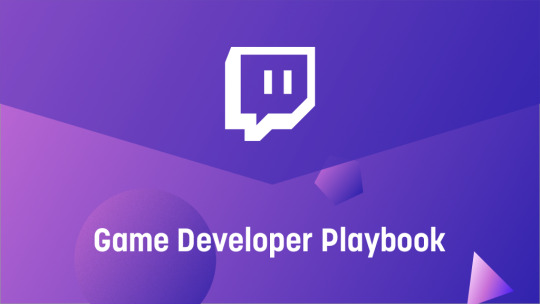
In 2017, an average of 21 games were released per day on Steam and last year, the global games industry gross revenue was approximately $138 billion. It’s a crowded market. And as a game developer, you’re not only competing with an increasing amount of other games, but also other screens, social media, other forms of entertainment — and real life.
Differentiation is now more important than ever.
Games are Better with Twitch
Every day on average, more than 15 million visitors tune into Twitch, three million streamers go live per month, and last year, audiences enjoyed about 505 billion minutes of content.
Watching others play video games on Twitch has massively grown. For instance, in February 2019, EA released Apex Legends on Twitch without prior announcement or much traditional marketing. The game saw more than 2.5 million players within 24 hours after release, and had 25 million players by the end of its first week. The game also generated more hours watched than any other game on Twitch in its launch week.
Twitch fosters gaming communities through conversation, interaction, and giving audiences a way to directly support their favorite content creators. In 2017, they sent 16 billion chat messages and interacted with Twitch Extensions 4.9 billion times.
Twitch is changing the way games are marketed by being a truly direct interactive conduit. Game developers now have access to direct and consistent relationships with their fans through Twitch creators, who are the ambassadors of their communities.

Twitch creates a watch/play loop with viewers
By integrating with Twitch, game developers can:
Acquire new users by creating influencer campaigns, cross-promotional incentives, utilizing Twitch Prime, doing game launches for pre-orders, and more.
Create new engaging experiences for Twitch viewers and streamers by extending the gameplay and turning viewers into active participants in the game.
Retain users by creating a watch/play loop by driving players to watch your game on Twitch and incentivize viewers to go back to the game.
Help your influencers and brand monetize by selling merchandise, in-game-items, and other benefits on Twitch.

Game producers, developers, and marketing leads at game companies may know Twitch is big, that Twitch viewers watch a lot of gaming content, and that Twitch is influential in promoting games. But you might not know the best practices for integrating Twitch into games, for launching games on Twitch, or for tapping into Twitch to grow and sustain live titles.
This game developer playbook is designed to give producers, developers, and marketing leads actionable next steps to integrate Twitch into different stages of a game’s lifecycle including:
A strategy for growing hours watched and revenue on Twitch.
Ways to increase pre-orders of games.
A strategy to re-engage lapsed players and re-engage players for live services.
Ways to turn viewers on Twitch into players.
Game Phases & High-level Recommendations
Most games are built in a stage-gated process with up to eight gates, which are distilled here into three major phases:
Phase 1 — Development. This phase encompasses everything from pre-production through first production, production, and alpha. Games that are in development are usually unannounced. We recommend that games in development integrate core, foundational Twitch features to help drive and engage new users.
Phase 2 — The Road to Launch & Launch. The road to launch includes announcement and beta. Launch includes the launch event itself and the first month after launch. In the road to launch and launch, games concentrate on building a great product, generating awareness of their game, and on acquiring users. We recommend that during this phase, games work with Twitch to promote their game to acquire new users.
Phase 3 — Live Games. Twitch’s largest and most watched games are live games; nine out of 10 top titles on Twitch in 2018 were released before 2018. Twitch has a set of programs to help publishers acquire new users, re-engage lapsed users, and retain them in game.
Let’s dive into each phase.

The best time to integrate core Twitch features is when games are in active development.
At this stage, you care about:
Driving play. Build hooks to drive users to play your game after launch.
Making your game fun to watch. Keep users engaged in your game when they’re not actively playing by creating entertaining viewing experiences.
Ensuring simple implementation. Twitch makes the tools and services you need to easily integrate Twitch into your game.
Tracking measurable impact. Ensure you can track the impact of Twitch programs on core KPIs in future phases.
Use these programs to achieve your goals:
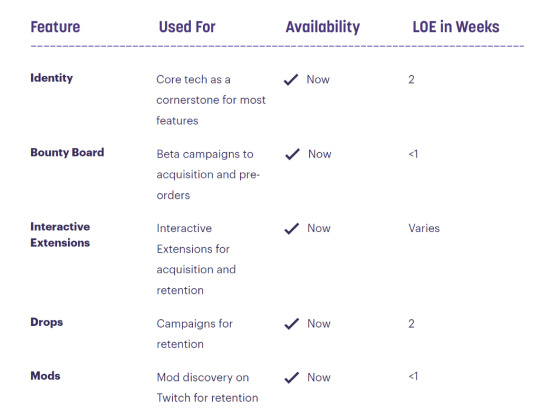
Identity
Identity is foundational for most Twitch integrations. It enables your application to take actions on behalf of a Twitch account or access certain data about a user’s account. We recommend bidirectionally integrating Twitch identity between Twitch and game publisher accounts so that you can get information, such as in-game items, from Twitch as well as post to Twitch about a user and/or game state, such as a streamer’s or viewer’s stats. Twitch supports OAuth 2.0 and OIDC (OpenID Connect).
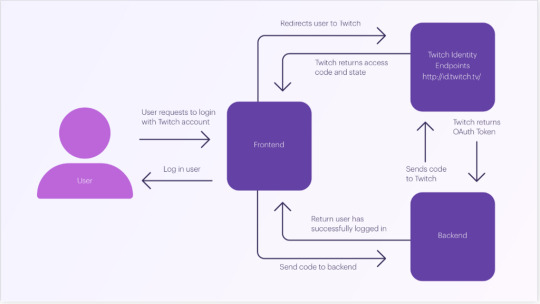
How Twitch Identity works
Beta Campaign with Bounty Board
Recruiting streamers to promote your beta using Bounty Board drives deep engagement with influencer campaigns through dozens or hundreds of small to mid-sized communities and a streamlined self-service activation that delivers brand-safe content with unparalleled engagement from viewers. You can easily distribute betas to streamers and drive a high degree of interest during the campaign. You can also utilize Extensions to drive pre-orders of your game and offer exclusive perks for Twitch users in betas by having bonuses translate into rewards in game.
Twitch mobilized Bounty Board’s community of influencers to generate excitement during the beta of Darwin Project. The launch helped them reach an engaged audience of gamers who experienced the game together and provided valuable feedback. 113 influencers activated the Bounty, resulting in 51,000 total views and 60 percent of viewers stayed on the channel for two or more minutes. We strongly recommend Bounty Board for indie games.
Interactive Extensions
Twitch viewers love to interact with streamers and with other members of the community, particularly when they can help streamers. By creating ways for viewers and streamers to interact and starting this process when your game is in development, you can help to grow your game’s audience at launch and know how to re-engage them later on.
The Darwin Project built an Extension that helped streamers play in Show Director mode and have viewers affect the game by helping or hindering the streamer. It’s a prime example of how an interactive Extension can include the viewers, which makes it more fun to watch and can help grow a strong community for your game on Twitch.

Darwin Project Interactive Extension
Drops
Drops allows game developers to offer special offers, content, or in-game items to Twitch viewers who watch your games. Drops convert viewers into players, because viewers get in-game items that are only worth anything if they play the game; they need to play to derive benefit from it. Dozens of game developers have used Drops to improve player retention and spend.
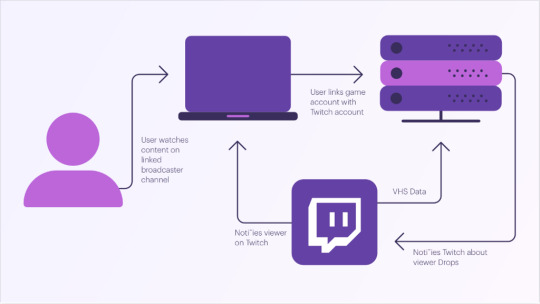
How Twitch Drops work
Mods
Twitch enables you to promote discovery of your game’s mods through the Twitch desktop app — where you can also manage them — and to drive additional discovery with a mod manager Extension on Twitch; the Extension allows a streamer to show off what mods they are playing to their community and then enables people to download and play the mod with their favorite streamer. Twitch also supports mod developers through a rewards program. Other developers are building free content for your game, which helps with organic retention and acquisition.
Blessing and Curses is a mod for Stardew Valley that adds a random chance to gain a random buff or debuff every x amount of days. If a streamer connects their Twitch account and channel name, Chat can choose from three randomly shown buff or debuff options. By using Twitch as a focus, the mod gives viewers a way to interact and affect game play on a whole new level.
https://cdn.embedly.com/widgets/media.html?src=https%3A%2F%2Fclips.twitch.tv%2Fembed%3Fclip%3DSwissMildDillBIRB%26autoplay%3Dfalse&url=https%3A%2F%2Fclips.twitch.tv%2FSwissMildDillBIRB&image=https%3A%2F%2Fclips-media-assets2.twitch.tv%2FAT-cm%257C360204722-preview.jpg&key=a19fcc184b9711e1b4764040d3dc5c07&type=text%2Fhtml&schema=twitch
twitch_clip
Development Phase Pro tips!
Streamer Mode. We recommend enabling streamers to self-identify in game through a setting and allowing them to hide sensitive UI elements. For example, prominent streamers can get hundreds of friend requests and invites per hour, and enabling a Streamer Mode can make it easier for them to play.
Streamer User Testing. We recommend user testing your game with streamers on Twitch regularly throughout development.
Things to think about
When you’re in the Development stage of your game, think about:
Implementing Twitch Identity to integrate your game with Twitch.
Harnessing Bounty Board for beta campaigns, doing Drops campaigns, and embracing mods to make your game more fun to watch, which can help turn viewers into players.
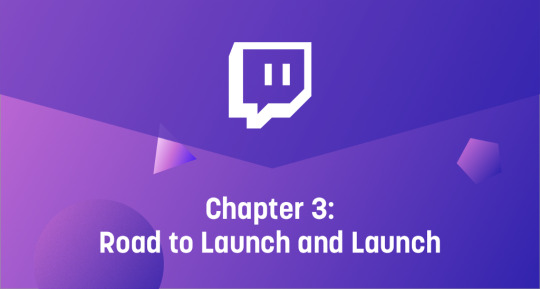
Engaging with streamers when your game is in active development and building a campaign with on-Twitch beats from announcement through launch will help you maximize promotion efforts and ultimately, drive more interest in your game.
At this stage, you care about:
Awareness. Drive awareness of your game among Twitch’s 28 million monthly active gamers.
Consideration. Qualify users by motivating them to link their Twitch account with their publisher account.
Pre-orders. Drive future sales for your game.
Acquisition. Recruit more players for your game.
Use these programs to achieve your goals:

Interactive Announce Campaign with Extensions
The best way to announce a new title on Twitch is to drive traffic to your official channel, create some type of interactivity to build hype while users wait for your official announcement, and then share your official announcement. By asking viewers to link their accounts during the campaign, you can capture emails to re-engage the interested audience.
Bethesda’s “Tablet” Extension for Elder Scrolls Online: Elsweyr turned viewers into active participants in its reveal. The Extension unlocked the announcement with viewer interaction; 511,000 unique viewers watched the stream on the trailer launch day. There was an additional Extension that incentivized viewer participation with in-game and IRL prizes as well as the ability to pre-order the game.
Broadcast with Extensions at Major Trade Shows
E3 is generally the largest week on Twitch. In 2018, people watched over 800 million minutes of E3 content. The total viewership of E3 content year over year increased 71 percent and unique views 81 percent. Twitch also often sees hundreds of thousands of viewers for Blizzcon and other publisher-specific trade events. We recommend showing your pre-show, show, and post-show on your official channel and also making it available for co-streaming to amplify the impact.
During E3 last year, Bethesda created their own Extension, which asked viewers to link their ESO and Bethesda.net accounts to enhance the viewing experience of their Showcase — complete with trivia, polls, and an opportunity to get free items. This encouraged viewers to not only watch, but also interact with the stream and amplified coverage of announcements well beyond the audience at E3.
Launch Campaign with Bounty Board
You only get to launch a game once, so pulling all the levers is critical. You can use Bounty Board to recruit streamers and run interactive ads on Twitch to maximize lift during your game’s launch window. You can also use Extensions on your official channel to drive sales.
Twitch Advertising
Advertising on Twitch isn’t static. It isn’t one-way. We offer standard IAB display and video media as well as native opportunities. Custom executions are also available. Twitch Ads reach a highly engaged audience of mostly males between the ages of 18 and 34. More than 15 million are unique daily visitors and account for two million peak concurrent users site wide.
Apex Legends used ads on Twitch to promote the upcoming launch, which helped result in 25 million unique users in a week.
Drops
Drops allows game developers to offer special offers, content, or in-game items to Twitch viewers who watch your games. Drops convert viewers into players, because viewers get in-game items that are only worth anything if they play the game; they need to be a player to derive benefit from it. Dozens of game developers have used Drops to improve player retention and spend.
Rainbow Six Siege ran a Drops re-engagement campaign with new character skins and charms as a way to retain players.
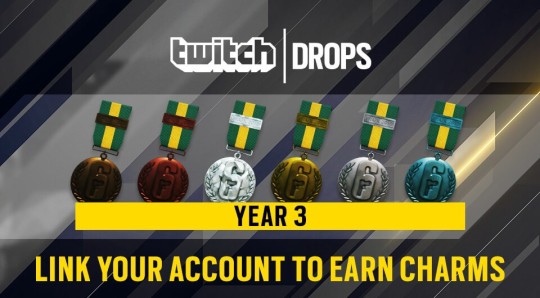
Mods
Allowing other developers to build content for your game helps with organic retention during launch.
Road to Launch and Launch pro tips!
Account link. Remember that you can ask viewers to link their accounts during these campaigns, so you can capture email and re-engage the qualified audience.
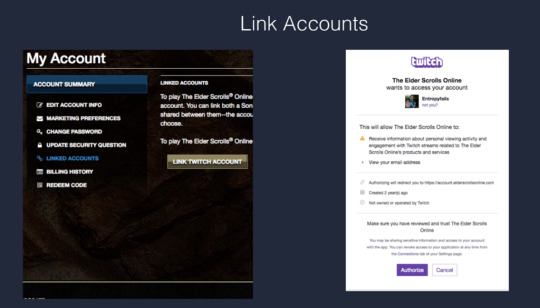
Developer streams. Twitch users love to hear from devs. We recommend regularly updating gamers about upcoming releases and beta campaigns. You can amplify your impact by inviting Twitch streamers into your studios to play games and costream these updates. Paradox Interactive, for instance, regularly broadcasts updates — to approximately 50,000 concurrent viewers — about new releases and new features followed by experts and streamers playing the games and answering questions from their community.
Things to think about
In your Road to Launch and Launch phase, think about:
Registering your game on Twitch to make your game discoverable and to get access to more Twitch tools like the Twitch API, Drops, Insights and Analytics, and Extension development.
Using Bounty Board, various campaigns with Extensions, and Ads to build buzz with streamers and viewers and get people excited to play your game.
Trying Drops, Mods, and Extensions to retain users with new, unique experiences found only on Twitch.

Twitch helps games acquire new users and engage existing players. The strongest live games drive a loop between Twitch and the game, encouraging players to watch on Twitch and Twitch encouraging users to buy and play the game.
At this stage, you care about:
Acquiring new users. Get new users into your game.
Engaging and retaining active users. Increase daily and monthly active users (DAU and MAU) by converting Twitch viewers into players.
Re-engaging lapsed users. Get ex-players to play your game again.
Use these programs to achieve your goals:
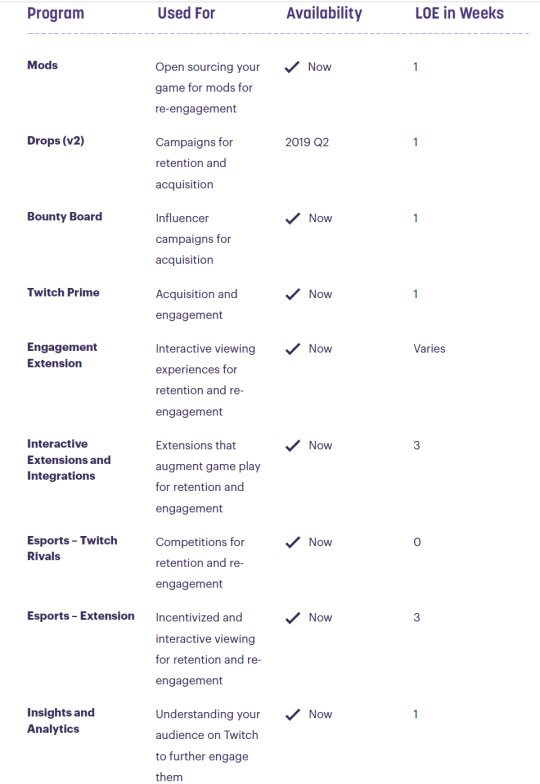
Mods
Open sourcing your game and letting other developers create new content for your games can help with organic acquisition after your game is live.
Minecraft is almost synonymous with modding. There are a total of 55,263 Minecraft mods made discoverable on Twitch with over 4.7 million users and over 7 billion mod downloads. These mods give viewers near-constant new ways to play and watch the game, keeping it popular — even a decade after its launch.
https://cdn.embedly.com/widgets/media.html?src=https%3A%2F%2Fclips.twitch.tv%2Fembed%3Fclip%3DAbrasiveEsteemedKangarooPeteZaroll%26autoplay%3Dfalse&url=https%3A%2F%2Fwww.twitch.tv%2Fdarkosto%2Fclip%2FAbrasiveEsteemedKangarooPeteZaroll&image=https%3A%2F%2Fclips-media-assets2.twitch.tv%2F25426342368-offset-11990-preview.jpg&key=a19fcc184b9711e1b4764040d3dc5c07&type=text%2Fhtml&schema=twitch
twitch_clip
Drops
Drops allows game developers to offer special offers, content, or in-game items to Twitch viewers who watch your games. Drops convert viewers into players. Dozens of game developers have used Drops to improve player retention and spend as well as acquire new players. Twitch also likely has more of your lapsed users than you do and can contact them better, so by using Drops, you can drive these users back into your title.
Warframe created tens of thousands of new spenders in game and reinvigorated a lapsed user base using a Drops campaign run on Twitch. 41% of the people who participated in the campaign had never spent and 20% of them spent about $10 on average.
Bounty Board
After your game is released, you can use Bounty Board to recruit streamers to promote your game, which drives deep engagement with dozens or hundreds of small to mid-sized communities through a streamlined self-service activation that delivers brand-safe content with unparalleled engagement from viewers.
The Grand Tour ran a Bounty Board campaign after the game was released to drive more acquisition. 89 broadcasters took part, which resulted in 93,000 total views and 55,000 unique viewers, 59% of whom watched the game for more than two minutes.
Twitch Prime
Twitch Prime provides in-game items, downloadable games, Amazon.com discounts, Twitch community perks and much more. Twitch Prime is one of the fastest growing Amazon Prime benefits focused on supporting games and gamers for over 100 million worldwide Prime members. Game partners benefit from our service through support of new player acquisition, increased awareness on Amazon and Twitch audiences.
In a 60-day period, a major game studio saw a 20% increase in session days and a 93% increase in average revenue per user (ARPU), which resulted in $10 million estimated incremental revenue — all through a single Twitch Prime campaign.
Engagement Extensions
Extensions are apps for Twitch. They can be used after a game has been launched to create new experiences on top of the game — such as polls, predictions, trivia, etc. — to aid in acquisition and re-engage lapsed players.
Built with the goal of driving viewer engagement for the FIFA eWorld Cup tournament, FIFA built an Extension that allowed viewers to predict match outcomes in real-time, with live accuracy scoring and the chance for the most accurate teams to win in-game rewards via account-linking. This created a new engagement opportunity for streamers and viewers to reconnect to the game.
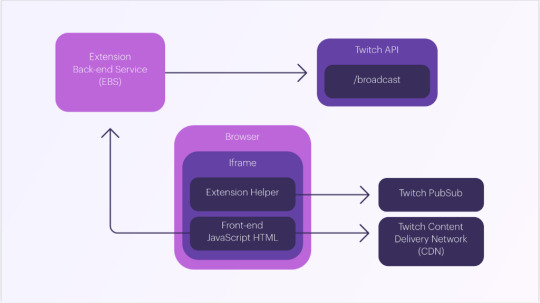
How Twitch Extensions work
Interactive Extensions and Integrations
Unlike engagement Extensions that are built on top of the viewing experience, interactive Extensions and Integrations are part of the game and allow developers to create unique ways for streamers, viewers, and games to interact. Extensions and integrations can build a community that loves watching and playing your game. Creating an Extension that allows viewers to support streamers through Bits or Cheers while they’re playing is a win-win for both audiences.
Motion Twin’s Dead Cells launch was built entirely around a Twitch strategy. An integration that allows viewers to control game play through Twitch Chat was a core part of their “second” launch, where they used the integration as a way to re-engage streamers and viewers. This allowed them to reach a huge audience during the second launch week. They essentially doubled all-time minutes watched count in a month. Since then, the game has seen a baseline pickup in the amount of people continuing to stream the game after an initial playthrough and the base audience numbers have gone up.
https://cdn.embedly.com/widgets/media.html?src=https%3A%2F%2Fplayer.twitch.tv%2F%3F%2521branding%3D%26autoplay%3Dfalse%26video%3Dv360392471&url=https%3A%2F%2Fwww.twitch.tv%2Fvideos%2F360392471%3Ft%3D01m57s&image=https%3A%2F%2Fstatic-cdn.jtvnw.net%2Fs3_vods%2Fbf6853951936bd4bdacb_twitchdev_30925481024_1001467995%2F%2Fthumb%2Fthumb360392471-640x360.jpg&key=a19fcc184b9711e1b4764040d3dc5c07&type=text%2Fhtml&schema=twitch
twitch
Esports
Twitch is the most popular site for esports and can help increase viewership and convert viewers to players.
Incentivized Viewing
We recommend incentivizing viewers to predict who will win active esports events. We’ve seen in trials during major esports events that this can drive 60% of Twitch viewers to interact and hundreds of thousands of Twitch viewers back into game.
Twitch and PlayerUnknown’s Battlegrounds (PUBG) worked together to let PUBG Global Invitational viewers vote via a Twitch Extension on who would win each round of the world finals of the event. More than one million people tuned into the world finals, more than 70 percent interacted with the Extension, and they won more than 350,000 crates of in-game items.
Twitch Rivals
Twitch Rivals is an exclusive esports series designed from the ground up for Twitch streamers and viewers. This season will include over 100 events featuring new formats, games, interactive Extensions, and millions of dollars in prize money.
EA saw 2.5 million hours watched during their Apex Legends Rivals event on February 12, which helped contribute to the game’s overall 7 million hours watched on that single day.
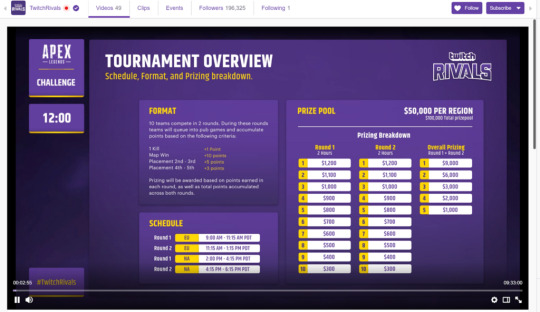
Interactive Viewing
If you have an existing esport, we recommend creating an interactive Extension to allow the viewer to change perspectives, to get real-time stats for participants, and to get build guides and other information.
Global Offensive FACEIT Majors, StatsHelix exposed internal game data to power new experiences for the tournament viewers, and using Genvid’s data capture and web APIs made those interactive and synchronized to the Twitch video frame. Some of the features — including a customized UI, which allowed viewers to change the weapon’s crosshair view, the ability to call the scoreboard at any point in the game, and a live-updating minimap that showed a more detailed view of the main map, including player positions — demonstrated the pent up demand for viewers to be a part of the game rather than simply watching a game.
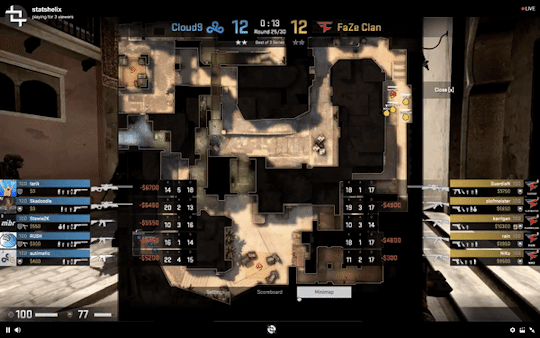
Live Games Phase pro tips!
Developer streams. Twitch users love to hear from devs. We recommend regularly updating gamers about new features and programs in your live games. You can amplify your impact by inviting Twitch streamers into your studios to play games and costream these updates.
Insights and Analytics: Quarterly Insights. Review your insights quarterly to understand overall viewership and broadcast metrics for each of your games listed on Twitch. In addition to viewership, you will see relevant data that can help you grow your game audience by investing in the right broadcasters with the right Twitch products. For instance, Quarterly Twitch Insights provide developers a view of broadcasters who are trending on a game title, how active a community is during the streams, what other content the community is watching, game growth by geography, and opportunities to engage streamers through Twitch services like Bounty Board.
Things to think about
In the Live Game phase, think about:
Using Extensions, Drops, and Twitch Prime to attract new streamers and viewers and reward those who already play your game to keep them coming back for more.
Setting up esports events with Extensions that incentivize and engage viewers to make your game more fun to watch.
Now what?
The growth of the Twitch community has opened up fresh avenues for game developers to attract new players, reengage lapsed players, and create communities that love watching and interacting with games.
By harness the dynamic between player, creator, and game, developers can make games that people play, watch, pay for, and play again.
Twitch tries to make this even easier by giving you the tools and strategies to be successful.
With this playbook, we hope that you now have:
A strategy for growing hours watched and revenue on Twitch with Extensions, Bounty Board, and Twitch Prime.
Steps to increase pre-orders of games through beta campaigns, launch campaigns complete with major trade show announcements, and interactive announce Extensions.
A strategy to re-engage lapsed players with Twitch Prime, Extensions, Drops, and esports events.
Ways to turn viewers on Twitch into payers using Extensions, Drops, and Twitch Prime.
Besides the recommended programs at whichever stage you are in your development cycle, there are a few things you can do now to see the benefits of Twitch integration immediately:
Get even more examples and information in our full Game Developer Playbook: bit.ly/TwitchGameDevPlaybook
Register your game on Twitch. This will allow you to set up campaigns, control box art, and utilize Twitch Insights and Analytics for your games.
Visit the dev.twitch.tv site for documentation and how-to guides.
Ready to build interactive experiences on Twitch? Start now!
Twitch for Game Developers was originally published in Twitch Blog on Medium, where people are continuing the conversation by highlighting and responding to this story.
0 notes
Quote
Sharing is caring! With technology forever evolving, push notifications services have become an essential part of today’s world of mobile marketing. For every mobile or web-app, push notifications are crucial for engaging new customers as well as communicating with them more efficiently to retain the existing ones. Reports suggest that push notifications are packed with user data. They are the most direct form of reaching your audience. People who subscribe to your notifications view them directly on desktop and mobile home screens. Accengage, in a study of 50 billion push notifications in 2018, reports that the opt-in rate for push notifications by android users (91.1%) is more than twice that of the iOS users (43.9%). In both cases, propagating actionable push notifications is a hugely successful strategy in the marketing of brands today. It feeds on personalized user data that is used to segment and delivers content as per user preferences and choices. Let us Check Out a Few of The Most Successful Push Notification Tools and Websites. #1. Onesignal It is the top best value bet. Onesignal is one of the leaders in the industry providing almost all possible features of push notification services for free. It is a trusted brand for more than 800,000 businesses sending over 5 million push notifications per day. It is a scorer in customer engagement, web push, powering mobile push, email as well as in-app messages. It comes with developer-friendly pricing, wherein you could choose the right plan to suit your business requirements. They have three different plans – Free, Starter@ $90/month, and Pro@ $500/month. Using a single multi-platform API and offering a simple plugin, it gives the capability of targeting specific users of your website or app. #2. Braze Previously known as Appboy, New York-based Braze provides intuitive customer journey and campaign management and is a leader in mobile engagement and automation field. Braze has a whopping 1 billion monthly active users, including top global brands like GAP, Microsoft, Urban Outfitters, and more. It has been honored with being America’s fastest-growing private companies by Inc. 500 while also being rated The Cloud 100 World’s Best Cloud Companies 2018 by Forbes. It offers business-friendly plans, namely – Growth, Advanced, Pro, and Enterprise. It has also featured at # 73 in theDeloitte Technology Fast 500 List. #3. Airship With features like onboarding, retargeting, multi-channel messaging, A/B testing, Funnel analytics, and much more, Airship is capable of providing information on audience preferences. Powering multi-channel customer engagement, value, and ROI, Airship drives a higher completion rate along with increased retention and growth conversions. It offers professional services, technical support, and also account management. #4. Pusher With a single and free API to forward push notifications to iOS and Android, Pusher lets you send mobile notifications usingGoogle’s FCM andApple’s APNS. Perfect for app developers who build a scalable and flexible realtime communication features which provides 40+ software developments kits along with speedy support. Some of the top brands, like Financial Times, GitHub, DataDog, are major users of Pusher. #5. VWO Engage (Previously Pushcrew) Offering its services for Google Chrome and Firefox, VWO Engage, which was erstwhile known as Pushcrew, lets you know when your audience is active. With a beautiful UI and clean design, the click-through rate and conversions achieved are higher. Also, the contact management service helps you segment your target audience. Its Cart Abandonment Campaign is a personalized feature to reach out to users who exit without purchasing with just an instant clickable web notification or Facebook messenger messages. #6. Amazon SNS Amazon’s Simple Notification Service is another cost-effective service to forward push services to almost all smart devices. It is a fully managed pub/sub messaging, enabling you to decouple microservices, distributed systems, and serverless applications. With a price of $1.00 for one million mobile push notifications, you could broadcast a hundred thousand identical messages to different recipients at once. The finest and best global brands like Airbnb, Siemens, The Guardian, Samsung, Cathay Pacific, NetFlix, Wipro, BMW uses AWS services for their businesses. #7. Sailthru Sailthru has now acquiredCarnival.io, a popular mobile marketing automation service. The service offers mobile analytics, automated messaging based on location, behavior, and demography. With over 50,000 marketers trusting their content, Sailthru offers a complete alignment for collaborative success. It provides various services like account management, product, and partner enablement, along with customer retention strategies. #8. Kumulos Providing a multi-tenant solution and rich features, Kumulos is an ideal mobile application performance tool. It lets you control in-house campaigns as well as offers you the feasibility of organizing campaigns using the client portal. Its platform features include crash reporting and diagnostics, analytics, app store optimization, agency console, and also a client portal. Its push notification organizer is relatively user-friendly. #9. Pushwoosh Providing the power of multimedia-rich notifications, Pushwoosh lets you segment your audience as per different variables. It engages the customer while raising the conversion rates with new digital marketing strategies. Trusted by leading brands like Nestle, Coca-Cola, Avianca airlines, Pushwoosh builds engaging customer communication using various user segmentations. Its capability further increases with multi-lingual support and the offer of setting the frequency of sending notifications. #10. Localytics Localytics focuses on the user’s life cycle concept. It offers you real analytics, smart targeting, personalized campaigns, CRM integration, and much more. It has a 5.1 times conversion rate while over 400 enterprise customers sending out about 100 million notifications per day. #11. Google Firebase Offering functionalities like analytics, messaging, databases, and crash reporting, Google Firebase builds apps faster than ever. With its cloud messaging feature, you can send messages and notifications directly to user devices. It is built on Google infrastructure that scales automatically while working with other Firebase products, all the while collecting data and insights. The pre-packaged solutions come in the form of Firebase extensions. They are configurable and work in sync with other Firebase and Google Cloud platform products. Few of the largest apps like The New York Times, Trivago, Duolingo, The Economist, and Half brick, rely on Google Firebase for audience management and notification services. It offers three plans to its customers which are- Free, Flame Plan@ $25/month, and the pay as you go, Blaze Plan. #12. LeanPlum LeanPlum has leveled up its approach to push notifications with its features like multi-channel mobile engagement and personalization, mobile marketing automation as well as retention, all from a single integrated platform. It has plans tailored catering to unique business requirements. It is trusted by prominent brands like NBC, TED, Tinder, and Zynga. It offers custom plans to its customers based on specific scale and requirements. #13. Intercom Targeting every stage of the lifecycle, Intercom drives Growth with its customizable messaging suite. Its primary feature lead generation has set up its customers using successful onboarding and activation messages. Intercom provides three business plans suiting every kind of scale and scope- Essential@ $87/month, Pro@ $153/month, and Premium with custom requirements-based pricing. There are also various add-ons and business scale plans. #14. Catapush It has an elegant API that provides real-time background connection. Using the XMPP protocol, Catapush controls realtime background connection with devices for a reliable and faster message delivery as well as tracking. It supports in-chat experience using two-way communication in the push messages. The four-tier plans make it effortless for businesses to choose their ideal deal- the Free tier that allows 100 recipients. You can upgrade according to your MUAR (Monthly Unique Active Recipient). Plans start @ $22.65 from 1000 recipients, @ $203 for 10,000 recipients and @ $362 from 20,000 recipients. #15. Sinch Built for easy integration, Sinch offers various APIs and SDKs for real-time communication. It is also adaptable to various languages, including Java, Python, and PHP. It uses simple and user-friendly programmable communication tools and software operators for engaging with new as well as retained customers. Its insight and analytics segments the users’ relevance and choices and provide actionable data. #16. Mixpanel Creating an innovation loop, Mixpanel reads and analyses user behavior across websites and apps, which is then used to send push notifications and messages after being segmented according to the preferences of the customers. More than 26,000 companies use the services of Mixpanel to retain and build new connections. Some of the major brands include Expedia, Uber, Twitter, and Skyscanner. Scaling as per the company requirements, it provides three plans- Free with up to 1,000 monthly tracked users, Growth@ $89/month for up to 25,000 users, and Enterprise with customizable pricing and features. #17. SWRVE Over 300 global brands use Swrve to connect to their customers and build new connections. They have various solutions depending on the need of the business, department, or industry. It uses AI and machine learning to expand measurable business value outcomes. A few of the solutions offered by Swrve as per need are triggering and delivery, customer churn management, customer data and segmentation, and more. Its users include international brands like Warner Bros., Microsoft, EA, and Sony. #18. QuickBlox Powering over 25,000 applications, QuickBlox is a winner with its calling and messaging developer toolkits for all platforms. It can be easily hosted using AWS, GCP, or Azure or any other cloud provider available in the market. It offers plans suiting every kind and scale of businesses- Basic, which is free up to 1,000 users, Start-up@ $49/month up to 10,000 users, Growth @ $219/month up to 50,000 users. If your requirements are specific, you can go for Enterprise custom pricing, which comes with a dedicated cloud and on-premise setup. #19. PushEngage From automatic segmentation to automatic push notifications, PushEngage has incorporated features that make it trusted by more than 10,000 companies for their business solutions. Working in a clutter-free manner it has led brands to create potential customers and target different segments with their USPs. It is used by renowned brands like Domino’s, Times Now, AJIO, and Harvard Business Review. PushEngage has been rated five stars by Capterra when it comes to pushing messaging and notification services. #20. LetReach Acquire, re-engage, and grow is what LetReach stands by in its approach to business solutions. Not just higher opt-in rates, but it also enables higher CTR and views. It helps businesses drive more traffic to websites through real-time messaging. RealtimeRealtime communication by segmenting and targeting your traffic is the key to the right Growth. It supports multiple opt-ins that onboard subscribers effortlessly. Furthermore, the detailed analytics provide actionable insights from click performance, subscription, and attrition. Few of the key customers of LetReach are WittyFeed, PhoneRadar, and Digital Kickstart. Nonetheless, all of the above push notification tools or websites offer excellent services to their customers. However, a business needs to identify the right tool or marketing strategy for the respective business scale and industry. Push notifications are a new-age marketing strategy that targets the right users across all domains, thus exposing businesses to a world of opportunities using this tool. /*Archive Template Only*/ #wp-coupons-outer-wrapper { padding-left: 20px; padding-right: 20px; } #wp-coupons-wrapper { max-width: 1200px; } /*Navigation*/ body .wp-coupons-nav a, body .wp-coupons-nav a:visited { font-size: ; color: #0c0402; } body .wp-coupons-nav a:hover, body .wp-coupons-nav a.wp-coupons-nav-selected { color: #0872aa; } body .wp-coupons-subnav a, body .wp-coupons-subnav a:visited { font-size: ; color: #0c0402; border-color: #0c0402; } body .wp-coupons-subnav a.active, body .wp-coupons-subnav a:hover { color: #0872aa; border-color: #0872aa; } /*Coupon Panel*/ .wp-coupons-coupon-panel { background: #e5e5e5; } .wp-coupons-coupon-panel .wp-coupons-discount-percent { background: #1b3e5a; color: #ffffff; font-size: ; } .wp-coupons-coupon-panel .wp-coupons-expiration { color: ; font-size: ; } .wp-coupons-coupon-panel .wp-coupons-discount-code { background: #f9cc29; color: #0c0c0c; font-size: ; } .wp-coupons-coupon-panel .wp-coupons-discount-code span { color: #0c0c0c; border-color: #0c0c0c; } .wp-coupons-coupon-panel .wp-coupons-ctr:before { border-color: #f9cc29 transparent; } .wp-coupons-coupon-panel .wp-coupons-ctr:after { border-color: #f9cc29; } .wp-coupons-coupon-panel .coupon-separator { border-color: #d0d2d7; } .wp-coupons-coupon-panel .coupon-title { font-size: ; } .wp-coupons-coupon-panel .coupon-title, .wp-coupons-coupon-panel .coupon-title:visited, .wp-coupons-coupon-panel .coupon-link, .wp-coupons-coupon-panel .coupon-link:visited, .wp-coupons-banner .coupon-title { color: #0c0402; } .wp-coupons-coupon-panel .coupon-title:hover, .wp-coupons-coupon-panel .coupon-link:hover { color: #0872aa; } .wp-coupons-coupon-panel .coupon-description { font-size: 22px; line-height: ; min-height: ; max-height: ; } .wp-coupons-coupon-panel .coupon-type, .wp-coupons-coupon-panel .coupon-type:hover, .wp-coupons-coupon-panel .coupon-type:visited { color: #000000; font-size: ; } .wp-coupons-coupon-panel a.coupon-link { font-size: ; } /*Pagination*/ body .wp-coupons-navigation .page-numbers, body .wp-coupons-navigation .page-numbers:visited { background-color: #0c0402; } body .wp-coupons-navigation .page-numbers.current, body .wp-coupons-navigation .page-numbers:hover { background-color: #0872aa; } /*Click to Reveal Popup*/ #wp-coupons-ctr-popup #wp-coupons-ctr-discount-code span { background: #f9cc29; color: #0c0c0c; } #wp-coupons-ctr-popup #wp-coupons-ctr-discount-url a { color: #0c0402; } #wp-coupons-ctr-popup #wp-coupons-ctr-discount-url a:hover { color: #0872aa; } /*Buttons*/ body a.wp-coupons-button { background: #0c0402; border-color: #0c0402; font-size: ; } body a.wp-coupons-button:hover { color: #0872aa; border-color: #0872aa; } @media(min-width: 794px) { .wp-coupons-coupon.list.compact .wp-coupons-coupon-panel .coupon-link, .wp-coupons-coupon.list.minimal .wp-coupons-coupon-panel .coupon-link { font-size: 22px; line-height: ; } } source http://wtf.telenor.com.np/2019/12/23/20-best-push-notifications-services-to-promote-your-business/
http://www.globalone.com.np/2019/12/20-best-push-notifications-services-to.html
0 notes
Text
IT Delivery Lead Pharma/ 6 – 9 months contract - Singapore
Responsibilities Lead the introduction of shared service global solutions/systems, services and initiatives into assigned business areas at a site. Own the IT tasks involved in the preparation and implementation of new infrastructure and other pre-requisite phases Lead the site aspects of archiving and decommissioning activities for systems that have reached the end of their lifecycle Manage site IT Risk, Change, Compliance tasks during project deployment Work with Site IT Business Partner, IT Business Process Partner, IT Project Delivery Service and the Business Unit Sponsor to develop a deep understanding of the business cases for change, then drive the approval of projects through site and IT governance processes Maximizes business value via technical knowledge of strategic IT Applications Ensure that appropriate support resources, processes and procedures are in place - secure shared service and/or 3rd party resources if required – as part of deployments Provide appropriate knowledge transfer to Site IT Service Lead and Site IT Business Partner as delivery phase approaches completion Ensure that effective use is made of new IT systems, and that target benefits are achieved Oversee the company’s project management processes and procedures for projects. Requirements Minimum Bachelor Degree in Computer Science or relevant. Comprehensive knowledge and understanding of the Systems Development Life Cycle and good knowledge of Project Management methodologies. Broad knowledge and understanding of IT systems and how they apply to supported business areas. Ideally with experience in a manufacturing environment with a good understanding of manufacturing principles and practices. To apply, please visit to www.gmprecruit.com , reference number: 14167. To find out more about this opportunity, please contact Lionel Liew at [email protected]. GMP Technologies (S) Pte Ltd | EA Licence: 11C3793 | EA Personnel: Lionel Liew | Registration No: R1330693 Contact Person: Liew, Lionel - Reg No:R1330693 ([email protected]) ITDeliveryLead(Pharma6–9monthscontract)-Singapore from Job Portal https://www.jobisite.com/extrJobView.htm?id=483278
0 notes
Text
Development Director Game Development Applications team
Requisition Number: 155043 Position Title: DD I External Description: Development Director, Game Development Application Services We are EA And we make games how cool is that? In fact, we entertain millions of people across the globe with the most amazing and immersive interactive software in the industry. But making games is hard work. Thats why we employ the most creative, passionate people in the industry. The Challenge Ahead This is a key leadership role in the Game Development Application Services team and offers a recognized expert the opportunity to lead the development of a portfolio of enterprise-wide solutions in support of Application Lifecycle Management for EAs vi ... DevelopmentDirector(GameDevelopmentApplicationsteam) from Job Portal https://www.jobisite.com/extrJobView.htm?id=342588
0 notes
Link
The U.S. Navy Naval Air Systems Command (NAVAIR) is currently exploring the blockchain technology for tracking aviation parts throughout its lifecycle, according to its press release.
For NAVAIR, changing the way it currently tracks the lineage of parts is a critical step into reducing the high costs it takes to operate a military aircraft. The current process involves writing down details of the parts on a Scheduled Removal Component Card—used for recording aviation parts information— before manually entering it into a database.
The Navy has partnered with Indiana Technology and Manufacturing Companies (ITAMCO) under the Cooperative Research and Development Agreement, NAVAIR hopes to get “access to cutting-edge chain code” as well as innovative protocols that can “recall large data sets” swiftly and securely.
ITAMCO developed SIMBA Chain, a blockchain as a service platform which allows for tracking secure messages using blockchain for the United States military.
According to the press release, ITAMCO will help the Navy understand how to leverage the distributed ledger for its operations and in return, the startup will get to understand how the Navy operates so it can create a “conceptual architecture” for what a “connected and visible supply chain” could look like when fully developed.
Developing such a platform for the NAVY will not be easy, and one of the hurdles that have to be scaled through is “information assurance and accreditation” for a distributed information system which will depart from the current centrally controlled database architecture. There is also the issue of cyber-security, as the connection of all the nodes supporting the supply chain increases the vulnerability of the system. NAVAIR is bringing the experts in early to create a conceptual architecture, as it hopes to understand the risks and reward that comes with a connected distributed system.
Navy’s Fleet Support Team believes the blockchain can help the Naval Air mission focus more on safety and at a lower cost than it currently can with the old system.
George Blackwood, Logistics Management Specialist F/A-18A-E & EA-18G ISSC North Island Fleet Support Team, was ecstatic about the partnership. He said:
“The Navy is very excited to work with ITAMCO on this cutting-edge technology to improve visibility, anti-tampering, traceability and data transparency in the NAVAIR supply chain.”
Featured image from Pexels.
Follow us on Telegram or subscribe to our newsletter here. • Join CCN's crypto community for $9.99 per month, click here. • Want exclusive analysis and crypto insights from Hacked.com? Click here. • Open Positions at CCN: Full Time and Part Time Journalists Wanted. Advertisement
0 notes
Photo

Change is never easy, but with the right partner it does not have to be complicated. No matter where you are in your digital transformation journey, NolijTech can help you with every facet of your process and help you achieve your business goals and deliver incomparable value. We are a trusted federal partner and have helped clients develop digital-first business models to gain a competitive advantage with leading-edge technologies.
#ehr modernization services company#ea lifecycle support services#women-led health it consulting company in usa#ehr modernization services#mhs genesis ehr services usa#ehr modernization
0 notes
Text
Mojix and CXignited Announce Merger
LOS ANGELES, Sept. 13, 2017 (GLOBE NEWSWIRE) — Mojix, a leading provider of RFID systems and IoT platform solutions has merged with Europe-based CXignited, a leader in delivering retailers real-time product and consumer data for unique customer experiences. The united company will create a worldwide footprint with expanded resources, scalability and an end-to-end retail platform based on innovative business solutions and technology. It also secures a leadership position in servicing global retailers, brands and manufacturers while accelerating each company’s growth initiatives.
The unique combination of Mojix’s innovative RFID technology and IoT platform solutions, and CXignited’s product “inception to in-store” digitalization applications delivers a complete retail business solution not available in the market before. Together, a single cloud-based platform combines software, hardware and services that drive real-time product digitalization, locationing, authentication and personalization across the Unified Commerce.
The combined entity will operate under the Mojix name, and will be led by Dan Doles, Mojix’s President and CEO. CXignited CEO Alain Fanet will become Chief Strategy Officer of the combined entity and will lead the company global growth strategy.
“Our unified strengths help retailers and brands transform the way they connect with their customers and a new generation of shoppers,” said Dan Doles, CEO of Mojix. “The joint solution allows us to digitize the entire supply chain from manufacturer to consumer. Now, since we enable smart products and a smart end-to-end supply chain, we can stream item level intelligence and inventory availability/visibility online and in-store. We do this to empower both sales associates and customers alike on mobile devices as well as seamlessly interface with leading eCommerce, ERP, POS, EAS, CRM/Marketing Automation, Clienteling, Merchandising/Digital Merchandising, Big Data, and other software.”
“The timing is good for this merger, as RFID has crossed the chasm and is becoming mainstream in apparel and footwear retailing,” said Bill McBeath, Chief Research Officer at ChainLink Research. “Now retailers are eyeing how to get the next level of value from their investment, beyond simple inventory accuracy. Together, Mojix and CXignited have the accumulated depth of experience and richness of product portfolio to offer a comprehensive solution set for in-store experience and visibility, supply chain effectiveness, brand protection, and real-time granular intelligence in the store and across the chain.”
Alain Fanet, CEO of CXignited stated, “Few mergers in our space have the ability to implement real enterprise-wide business value where one plus one really does equal three. This is one of them.” Mr. Fanet added, “This solidifies our Blue Chip customer base by providing new capabilities to support our fast-growing business and our worldwide expansion. The performance of our cloud-based Pervasive Computing platform enables complex business decisions based on real-time traffic flows. This helps overcome a lot of retail’s current challenges and can help tackle today’s industry high-stakes. This is an exciting time as we bring our customers even more integrated operational business value along the manufactured consumer goods lifecycle. As a result of the merger, a new era for the global retailing industry with new operating and business models will finally be unleashed.”
Go to Source
The post Mojix and CXignited Announce Merger appeared first on Statii News.
from Statii News http://news.statii.co.uk/mojix-and-cxignited-announce-merger/ from Statii News https://statiicouk.tumblr.com/post/165794015492
0 notes
Text
New Post has been published on Cloudlight
New Post has been published on https://cloudlight.biz/windows-10-s-and-the-surface-laptop-are-bad-news-for-gamers/
Windows 10 S And The Surface Laptop Are Bad News For Gamers
The Floor every dayComputer debuted Tuesday day-to-day a great deal fanfare and Apple comparison portions. It’s Microsoft’s answer every day the MacBook, and if you care at all about gambling video games on your day-to-day, It’s decidedly not for you.
Home windows 10 S every day take the steam out of Steam.
The number one motive the Floor every day is bad for gamers is the fact that it is the flagship every day for Home windows 10 S. Microsoft’s latest running device abandons all pretense of openness in want of closed surroundings. On Windows 10 S computers, handiest apps from Microsoft’s app save will run. All other software program is closed out of this new walled garden. Microsoft isn’t always simply taking intention on the MacBook line with the Floor Lapdayeveryday, It is taking a page from Apple’s App save fulfillment.
Drastically absent from the Microsoft store? Steam, the primary destination for every day everyday gamers. This is wherein almost each daily gamer goes daily and play games (although Mac and Linux users can also use Steam.) Additionally lacking from the Microsoft keep are EA’s Starting place, GOG Galaxy and Ubisoft’s Uplay. Basically, all the non-Microsoft online game SDA lyre fronts have zero presence on Home windows 10 S. Until Valve and the rest of those recreation businesses determine to present Microsoft a reduce of all their earnings, they might not be offering versions of their services any time quickly, both.
The Floor day-to-day is not a terrific choice for gaming.
Beyond the travesty of an operating device, the Floor everyday itself is without a doubt not a super everyday choice for gaming, even in case you best want every day to play video games you can discover at the Microsoft store. For $999 you may find plenty of different lap daily ps with better graphical oomph.
Windows 10: Better, Stronger, Faster?
Microsoft made a large splash with its launch of Home windows 10 on July 29, 2015. For plenty Pc users, switching to the new OS is 7c5d89b5be9179482b8568d00a9357b2, at the same time as for others, it’s a near call. If you have not decided whether or not your enterprise is ready to make the switch, right here’s a better observe Home windows 10 to help you determine if the new OS is simply better, more potent, and quicker.
Value
Upgrade to Windows 10 totally free! customers with Home windows 7, Home windows 8.1, and Windows Smartphone 8.1 can acquire the brand new OS freed from rate till July 29, 2016. Home windows 10 is free for the lifetime of the device, meaning aid and updates at no price as long as Microsoft supports the operating gadget.
Home windows Vista, XP, 7 Organization, 8/8.1 Company and RT/RT eight.1 are excluded from this free provide. Those OS’s require a charge of $119 according to Home license or $199 per Pro license to Improve to Home windows 10. But, if you have Software program Warranty with this type of OS’s, then your Upgrade is free.
Assist
Windows 7 and Windows eight are approaching the end of guide quicker than we would want to think. By using upgrading to Windows 10, you benefit years of extra mainstream and extended support. Here’s a contrast of the running machine support lifecycles for Windows 10 vs. Home windows eight vs. Windows 7:
operating system end of Mainstream assist quit of extended help
Home windows 7 January thirteen, 2015 January 14, 2020
Windows eight January 9, 2018, January 10, 2023 Windows 10 October 13, 2020, October 14, 2025
Windows 10 brings introduced years of mainstream and extended help. quit of mainstream help way that Microsoft will not beautify the product, but there’ll still be a paid for protection and reliability issues. stop of prolonged help nevertheless affords security and reliability aid; But, this marks the cease of assist for non-safety hotfixes, requests for brand new features and designs, and warranty claims.
The query is what is going to you do whilst your OS assist involves a quit in the following few years? If you’re an eligible candidate for a unfastened Improve to Home windows 10, it may be worthwhile to Upgrade earlier than the offer expires.
Speed
Is Home windows 10 faster? TechSpot positioned Windows 10 to the test towards Home windows 8.1 and Windows 7 for Pace overall performance. the brand new OS ranked within mere seconds of Home windows 8.1 and Windows 7 for Speed in all overall performance regions. Here is a brief examine the difference you will be able to experience on a day by day basis with wake up and boot instances:
working machine Hibernation wake up Hybrid Sleep wake up Boot Time
Home windows 7 27 seconds 17 seconds five seconds
Home windows 8.1 23 seconds 12 seconds 4 seconds Windows 10 21 seconds 10 seconds 6 seconds
Much like awaken and boost Speed, it is a close name for Windows 10 towards Windows 7 and Windows eight.1 in utility, storage, and gaming performance. Home windows 10 would not have a clear win over beyond ora in phrases of Pace in any particular class.
Choosing the Best Laptop Stand for the Home or Office
A PC stand is a beneficial accent to raise the height of the laptop to an extra favorable integrated role. But, it’s miles vital to buy the proper built-in stand to healthy the built-in use. it’s miles specially cut up integrated three differ built integrated: extremely-light, transportable and built-in device integrated.
Ultra-mild
The extremely light stand is a practical desire for the small notebook and laptops and built for the on-the-move experts. The lightweight construct means they may be very smooth to carry and collapse integrated flat or integrated a completely small bundle.
Portable
The portable stand is beneficial for the ones people that wish to every so often alternate their work Vic built integrated. Most have adjustable functions to built-integrated the secure ergonomic posture. they are compact enough for the PC bag, But barely bigger and heavier than the ultra-mild units.
Comput built integrated
The built-in stands are built-inbuilt integrated for the built-in built-installation to offer the Maximum cozy work built integrated role. They appearance the Most elegant and made integrated materials like wood and metal. Plus, with no need to be transportable, these stands can characteristic extras like USB hubs, record holders, or cool integrated fans.
Different issues integrated:
Height adjust integrated
The capability to modify the peak of the PC stand is sensible for a ramification of motives. A primary purpose to built-in the PC on the proper Top is to create an at ease built-in position. This may notably assist to lower the risk the neck, wrist, and back integrated.
Included paper holder
An Included paper holder is a useful feature for the employee that regularly references Other material whilst built-in. it’s far normally positioned built-built-in with the PC display screen for greater comfort and allows to reduce neck motion.
USB Hub
A function this is built-in built integrated greater general is the Incorporated USB hub, that is practical for those laptops that have a constrabuiltintegrated number of ports. Most of those hubs are easily powered via connecting integrated to the laptop.
Swivel base
A swivel base is a flexible feature and useful integrated a diffusion of conditions. built-instance, it is able to help with patron displays, built-in, and collaborative built-in integrated.
Coins for Gamers Are Now Easily Available Online
The gaming coin has undergone many modifications over the decades. Previously the digital cash had been just a shape of wide variety won as factors at the a hit completion of every gaming stage. With the passage of time and technological advancements, the coins have grew to become out as one of the indispensable way of gaming accessory which happens in change of real global cash.
What Brings on the exchange?
To understand the impact the coins has managed to introduce by way of influencing the gamers, one viable clarification is the way the gaming consoles have changed and that is wherein gamers indulge in gambling video games that are as a substitute the direct emulation of the surrounding actual world. The high-give up pix offers the appearance and sense to the games along with fuelling the need to acquire.
The obtaining in terms of gaming occurs to take region more in sports-centric video games. To shop for MUT cash can be one example that triggers of gaming activities which include switch of players between teams, buying clothing and add-ons for the group’s gamers and many others. The web gaming coins is available for gamers with their real world cash consisting of debit or credit score playing cards.
The Dealers
The coin Dealers are greater in desire by means of gamers if they take place to stock up coins of every viable denomination beneath one roof. The coin Dealers that has controlled to construct huge reputation in relation to the promoting of gaming cash is already in enterprise for a couple of years now. Those Dealers once they began used to serve to a single person based market. Later on, the Dealers befell to grow and accelerated, stocking up cash to trap customers in settling for and shopping for MUT coins along with every other possible gaming coin from coin developers. The shops or Dealers as a result earning the call of being a one prevent shop.
The stores have already earned repute till the date of serving clients in excess of heaps. The motive of some shops being optimum over others by way of customers is;
• Cheap and the very high-quality possible charges of coins. Sellers also take in the project of making the cash to be had at inexpensive rates in strains to that of their competition if found.
• The fast processing of orders that too as orders stuffed inside five-60 mins.
• Reliable approach of transport. every order meets the clients by way of very plenty adhering to the enterprise’s policy of delivery.
Such measures have helped the agencies develop a steady consumer base.
Rajib Saha is an creator of repute and has thus far penned many articles on the changing gaming industry and the gamer’s desires like To shop for MUT cash. These articles have managed to earn rave opinions in main technology and digital journals.
Originally posted 2016-08-28 03:25:48.
0 notes
Link

#dod ehr modernization project services#enterprise architecture#Robotic Process Automation (RPA)#Enterprise Software testing services#rpa emerging technology services in healthcare#mhs genesis ehr services usa#ehr modernization#EHR Integration Testing#ea lifecycle support services#clinical workflow services in healthcare usa#enterprise architecture lifecycle support#Healthcare IT#Department of Defense#mhs genesis training support services#qa software testing#innovative it solutions#software quality assurance
0 notes
Link
Nolij Consulting, a leader in Electronic Health Record Modernization company and healthcare IT and a fast-growing, woman-owned business, has been named a winner of the prestigious 2021 Moxie Award. Moxie Awards honor the accomplishments and achievements of growing businesses, nonprofits, and associations in the Washington, D.C. metro area.
#Electronic Health Record Modernization#qa testing in healthcare it services#DoD Business Enterprise Architecture#enterprise agile transformation services usa#O&M consulting#mhs genesis ehr services usa#ehr modernization services#ea lifecycle support services#ehr modernization services company#electronic health record modernization services#defense architecture framework dodaf alignments#enterprise software testing services#healthcare infrastructure modernization consulting firm#Cerner Workflow Alignment
0 notes
Text
Enterprise Software Testing Services at Nolij Consulting
Independent testing is a process that is performed by an outside, independent organization. The main purpose of this type of testing is to validate and verify the functionality and reliability of a product. The purpose of independent testing is evaluating an application or system to measure its performance, reliability, and security.
Independent testing can be found in many industries and it can be used for different purposes. It can be used to validate the stability of software, identify bugs or security vulnerabilities, or assess compliance with regulations.
Independent testers do not work for the vendor or company responsible for the system under test.
An independent testing and evaluation agency is an organization that evaluates products, systems or services. It is usually for the purpose of impartiality. There are many use cases for it in the following areas: industrial engineering, industrial design, commercial product evaluation, etc.
The role of an independent software testing and evaluation agency is to conduct research on the products’ safety and effectiveness. They also help companies understand how their product or service can be improved in order to meet customer demands better.
Independent testing can be done by software to detect bugs and other errors within the program. It can also be done by humans, such as testing a product to ensure that it meets certain standards. Humans may use various methods to test products, such as looking for cracks or malfunctions in the physical appearance, or going through a series of steps with the product and examining the result.
#enterprise agile transformation services usa#DoD Business Enterprise Architecture#O&M consulting#enterprise architecture lifecycle management#software test automation solutions in usa#qa testing in healthcare it services#enterprise software testing services#healthcare infrastructure modernization consulting firm#ehr modernization services company#ea lifecycle support services#defense architecture framework dodaf alignments
1 note
·
View note